The writing style guide is based on Penn State University Style and the Associated Press Stylebook.
Why a style guide?
The overall reputation of Penn State Health and Penn State College of Medicine as a leader in the core missions of education, research, community health and patient care reaches audiences ranging from local to worldwide.
Our reputation can be influenced by how we present ourselves to the public. As much as how we handle relationships with colleagues, peer institutions, the news media, our students and patients, our logo (or brand mark) and overall visual identity make a statement about us. They are an outward expression of our organizational personality, values and goals.
Clarity and consistency convey our commitment to trust, quality and the core values that serve to enhance public perception of Penn State Health and Penn State College of Medicine.
The consistent application of our visual identity guidelines benefits Penn State Health and Penn State College of Medicine in many ways. Increased recognition of our brand identity and its association with all our missions and each of our enterprises means increased understanding and appreciation of our values among and within the many communities we serve.
These guidelines are designed to help you apply our organizational identity to the materials used to communicate to many audiences. Use them to help Penn State Health and Penn State College of Medicine project a consistent image of trust and quality.
Penn State Health and Penn State College of Medicine’s name and look
Our name and graphic identity are vital parts of building and presenting our image. Protecting our logos and marks – that is, using them correctly and consistently – helps strengthen the image of Penn State Health and Penn State College of Medicine and the value we create for those we serve.

Why we protect our name and images
Careful management and ongoing revitalization of our brand identity is necessary to effectively represent our ever-evolving health care system and make a clear, consistent and distinctive statement about the quality of our organization.
Our name and symbols represent past generations of achievement by our health care providers, scientists, faculty, students, staff and alumni – and the continued promise of excellence in our missions now and in the future.
Our ultimate goal is to make the Penn State Health brand mark one of the most recognizable health care symbols in the nation. Using Penn State Health’s logo correctly adds value to all those affiliated with it, bringing respect, trust, confidence, and economic benefit to our organization, our partners and our communities. Additionally, consistent use of a recognizable logo reinforces the overall positive identity of Penn State Health.
Using this standards guide
This guide answers the questions commonly associated with the use of Penn State Health and Penn State College of Medicine logos, trademarks, and word marks. You’ll find important information on the use of the name and image. You can also find detailed information about Penn State’s visual identity standards on the University’s Strategic Communications website.
If you need help
If you have questions about this information, contact the Office of Marketing and Communications at 717-531-8606 or Marketing&Communications@pennstatehealth.psu.edu.
Jump to topic
Search
Logo Guidelines
The Penn State Health and College of Medicine marks are based on the visual identity system of our parent University, Penn State.
The health system mark in its entirety consists of a “Penn State Health” logo type and a shield, as shown below. These elements are proportioned and positioned in a specific way. This precise arrangement may not be altered when featuring the entire mark. The official Penn State Health colors are blue specifically Hex #003087 (Pantone 287) and Hex #6CACE4 (PMS 284) and white.

The mark is used to identify everything we communicate through our websites, print communications, presentations, social media profiles, signs and other visual media. Having a clear and consistent visual identity helps build greater recognition for and awareness of Penn State Health and Penn State College of Medicine.
Never redraw or try to recreate the mark, including the shield or the logotype. Any modification of the mark diminishes its impact and weakens our legal protection. Only authorized artwork may be used.
The primary mark is used in the majority of applications. Special-use marks shown below have an important but limited use.

Two vertical or centered marks below are reserved for special situations where formal center axis design would require the use of a vertical mark. There are other situations where the mark is used alone on an application, such as a folder cover, sweatshirt or cap. In these cases, a vertical mark may be more effective.
In the horizontal mark and vertical mark 1, the size relationship between the shield and the logotype are the same.
On the vertical mark 2, the logotype is smaller and above the shield. This allows for a larger, more powerful use of the shield. This version is very effective on some products and merchandise. This mark also can be useful when the width is restricted, as in a banner.

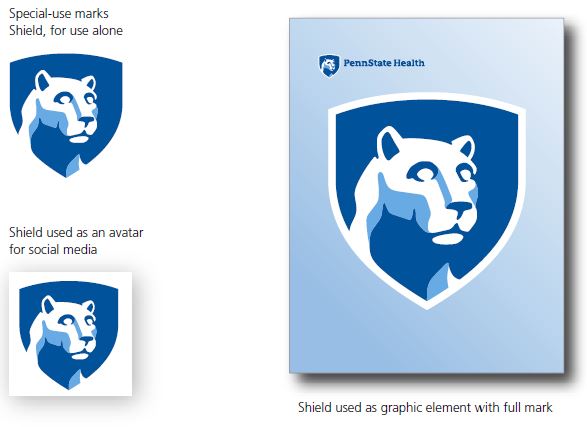
In general, the shield should not be used without the logotype. However, for certain uses, such as a pin or social media avatar, the use of the shield alone is appropriate.
Although the logotype is not used in these applications, the name does appear in close proximity.
The schematic folder cover demonstrates another opportunity to use the shield on its own as a graphic element. This design approach is only to be used when the full mark appears on the same surface.
Avatar icons used on social media sites are as .jpgs.
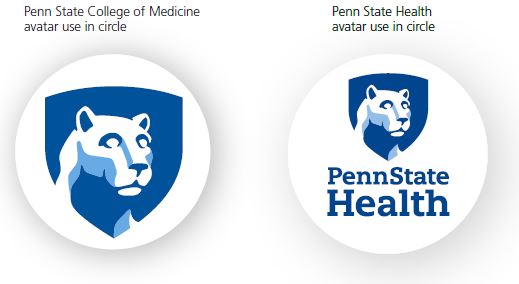
The Penn State Health social media avatar is for all Penn State Health hospitals, medical groups, centers and institutes.
The Penn State College of Medicine social media avatar should use the shield-only avatar to follow Penn State’s consistent approach to brand architecture.
Unique avatars for special events or programs affiliated with Penn State Health or Penn State College of Medicine should not be used.
Email Marketing&Communications@pennstatehealth.psu.edu with any questions you may have.
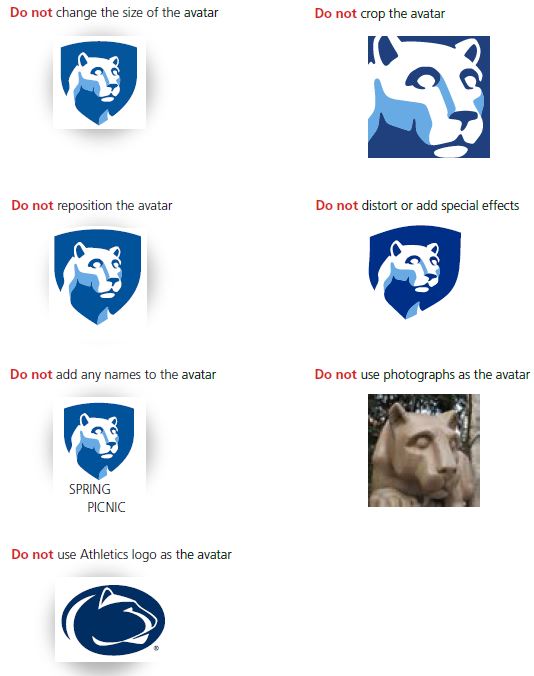
The incorrect avatar use in this section is representative of the ways in which marks are often misused. The incorrect use of a mark tends to give license to, and spawn, other misuses.
Never redraw or try to recreate the avatar. Any modification of the shield diminishes its impact and weakens our legal protection. Only authorized artwork may be used.
Brand architecture is a powerful tool that allows us to connect the many entities within Penn State Health and Penn State College of Medicine in a clear and logical manner. We achieve this by creating a system of the entities that use the mark, as shown here. These entity marks include our campuses, colleges and many administrative or academic units.
Tier 1: We refer to Penn State as a Tier 1 mark because it is the overarching entity to which all other entities are connected. Likewise, Penn State Health is a Tier 1 mark because it serves as the master identity mark for all health system enterprises.
Tier 2: This tier includes Penn State College of Medicine and the various hospitals within Penn State Health. The typeface and size relationships in our marks have been carefully resolved to provide a strong presence for Penn State Health while allowing for the addition of the entity names.
The same principles on color use, clear space, minimum size, etc., shown through these standards apply to our entity marks, as well.

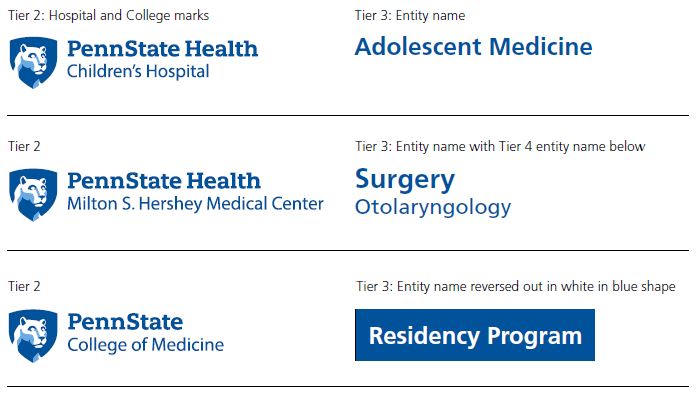
It is possible to communicate and identify a Tier 3 without using it as part of an entity mark.
The schematic demonstrations in this section show different ways in which a Tier 3 entity can be used next to a Tier 2 entity.
The first example shows how the institute name can be used at a small size near the Penn State Health mark. In this example, and all examples in this section, note the Tier 3 name should never impinge on the clear space surrounding the marks. The names should be in Beaver Blue Hex #003087 (Pantone 287), Nittany Navy Hex #041E42 (Pantone 282), Pugh Blue Hex #6CACE4 (Pantone 284) or black Hex #00000, to be in harmony, and not compete, with the entity marks.
In some situations it may be useful to place the Tier 3 name large, as shown in the second example. Here we show Otolaryngology, the Tier 4 entity, linked with the Tier 3 name, Surgery, and the Tier 2 entity.
In the third example, we demonstrate how reversing the name out of a blue band can be an effective way of both linking and separating the Tier 2 and Tier 3 entities. Reversing the name in color out of a photograph is also a strong way of identifying our entities while communicating useful information.
Institutes and centers are important entities within Penn State Health. If an institute or center is housed in Penn State Health St. Joseph Medical Center only. For example, use the St. Joseph Medical Center mark and separate the institute or center name from the main mark.

If an institute or center is interdisciplinary, with more than one administrating medical center or medical group, use the Penn State Health mark and separate the institute or center name from the main marks.

The purpose of these two systems is to allow the institutes to link back to Penn State Health. We want to avoid situations where two or more Penn State Health marks would be used with a single institute
or center.
Note the Tier 3 names should never impinge on the clear space surrounding our marks. The names should be in Beaver Blue Hex #003087 (Pantone 287), Nittany Navy Hex #041E42 (Pantone 282), Pugh Blue Hex #6CACE4 (Pantone 284) or black Hex #00000, to be in harmony, and not compete, with our entity marks.

The institutes, centers, departments and programs should not use highly distinctive symbols or logotypes. The examples shown here demonstrate how type treatment can be used to create visual interest and distinction without competing with the College or Penn State Health marks.
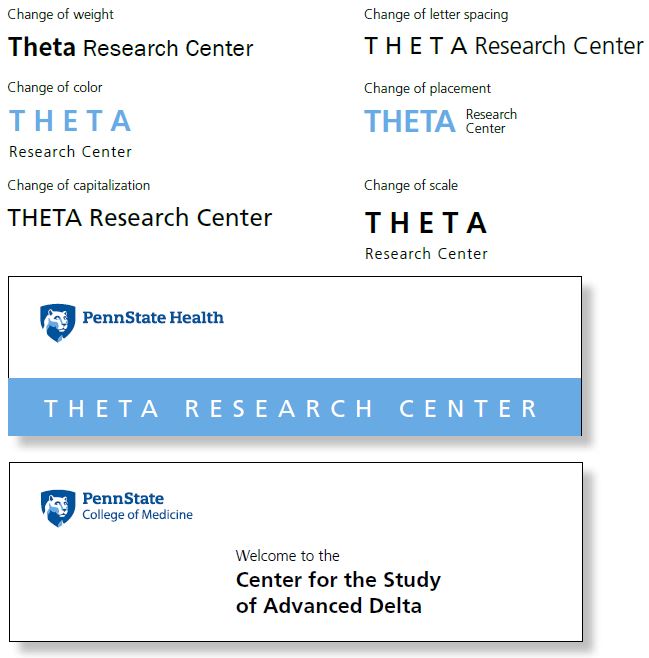
The institute and centers should always be seen in context with the College of Medicine or Penn State Health marks.
Do not use entity marks similar to those below:
Do not use a Tier 3 name with an entity mark

Do not use a Tier 4 name to replace a Tier 2 name in an entity mark

The incorrect mark use in this section represents the ways that marks are often misused. The incorrect use of a mark tends to give license to, and spawn, other misuses.
The two-color marks are the preferred versions, as they provide the most effective presentation. These two-color marks should be used whenever possible.
Our reverse-use marks are not simply the positive marks with a white logotype. The scale, position, and weights have been optically adjusted. Use the reverse-use marks for reverse applications.
The one-color blue mark can be used as a cost-effective alternative. The one-color black mark is permitted where printing in black is required, such as a newspaper ad.
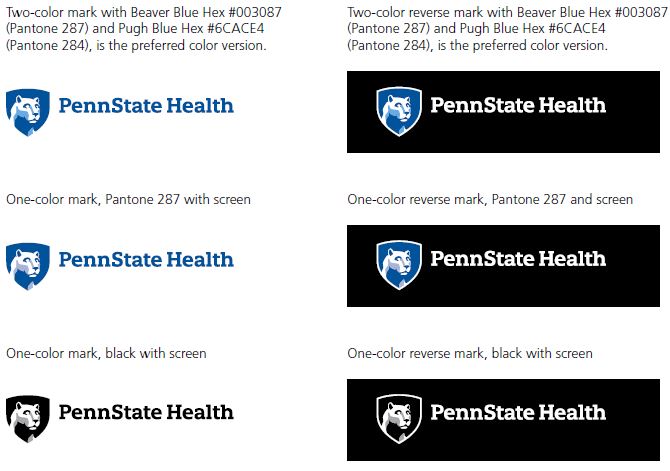

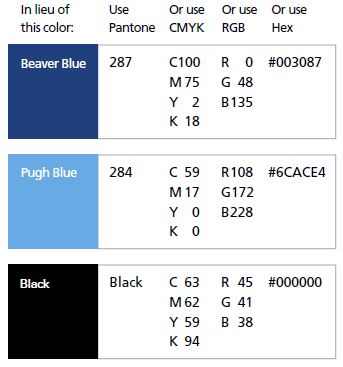
The preferred color version is the two-color mark with Beaver Blue Hex #003087 (Pantone 287) and Pugh Blue Hex #6CACE4 (Pantone 284). This two-color mark is preferred and should be used on most applications.
One-color applications may use Beaver Blue Hex #003087 (Pantone 287) with a 30% screen as a cost-saving measure, or black Hex #00000 with a screen, which is intended primarily for ads in newspapers or other inexpensive applications.
Logo artwork has been prepared for all color combinations demonstrated here. There is Pantone artwork for match-color printing, CMYK artwork for four-color process printing and RGB artwork for web and desktop computing applications.
The information in this section provides color code specifications to manage the mark colors in: Pantone, CMYK, RGB or Hex. Colors look different in application, from match-color to four-color process, from page to screen, and even coated to uncoated paper stocks. When trying to match our colors in other media, such as a thread for stitching or silkscreen, use the Pantone coated color swatch to match.
Our color palette is broad to allow for the appropriate expression of our brand personality. This does not mean all colors should be used at once. In fact, such usage is not recommended. Use good design sense and work with the personality attributes in mind.

We can use the mark on both light and dark colors. These colors examples are not part of a specific color palette but for demonstration purposes only.
This is possible because of the white outline around the shield, which provides a separation from the background and prevents common conflicts between marks and backgrounds with similar values or hues. The use of subtle textures is also possible.
In Figure 1, the positive-use mark with the blue logotype is used on a light background, and in Figure 2, the reverse logo has white logotype on a dark background. Also, placing the mark on another color or photographic background, like shown in Figure 3, is acceptable, as long as it adheres to the visual identity standards.

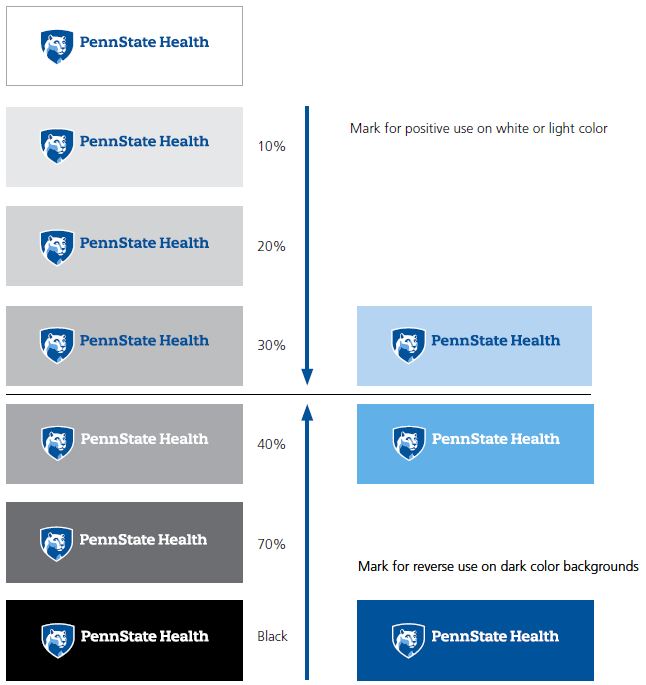
There are two marks: one for use on white or light color backgrounds, and one for use on dark backgrounds. They look very similar; however, the reverse mark is slightly smaller than the positive-use mark because the white outline makes the mark appear larger. The logotype also is drawn slightly thinner because white letters appear bolder than dark letters on white.
Simply put, they have been optically corrected. They are equally simple to use. Just remember to use the reverse mark on backgrounds that are darker than approximately 35% black, as shown to the right. This also applies to color backgrounds or simple background photographs.
The middle background values, from 30% to 40%, are the most challenging for the legibility of the logotype.
These background principles apply to the vertical marks, as well as all entity marks.
Never redraw or try to recreate the mark, including the shield or logotype. Any modification of the visual identity diminishes its impact and weakens our legal protection. Only authorized artwork may be used.
One color without any screens can be used for foil stamp printing, embroidery, embossing or debossing. It can be used in blue, black or white. These marks should not appear in other colors with the possible exception of silver or gold.
The use of the two-color primary horizontal mark is always preferable. While this one-color mark appears to be the same as the primary mark with the light blue removed, it has important differences.
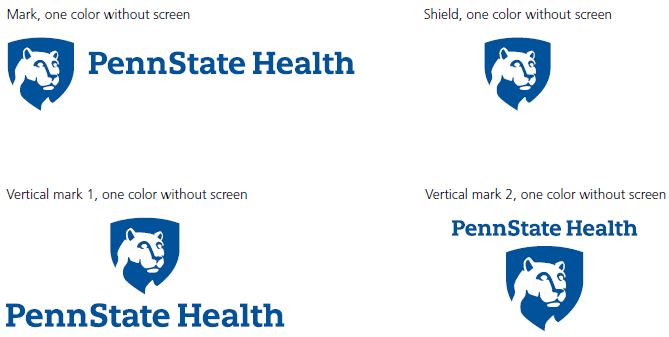
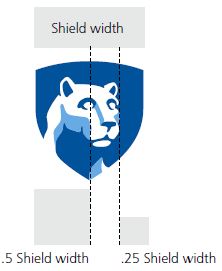
To effectively identify Penn State Health and Penn State College of Medicine communications, the marks must have visual presence.
One way to ensure the visual presence of the marks is to maintain a protected area or clear space surrounding them, where no other elements may be placed. Headlines, text, graphic elements, imagery and the edge of a page are not permitted within the clear space. The light gray square is set by the width of the shield, as shown, and the outer line defines the minimum clear space.
These minimum space requirements apply to the vertical marks and the shield when used alone. As shown, it also applies to the entity marks.
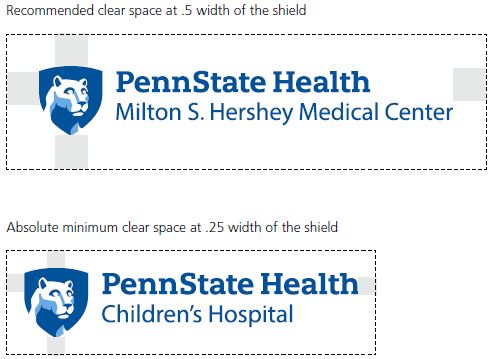
The size of the mark is important. A mark that is too large can appear aggressive and clumsy. A mark that is too small can appear weak.
The marks to the left are measured across the width of the shield. We use this dimension so that it can apply to the entity marks, as well. Most of our artwork is set up with a mark that is one inch wide and with a clear space of .5 inches or half a shield around the mark.
Key factors in determining the correct size include how the mark will be seen and what other information is included with the mark. In some cases, such as a sign, there may be a need to make the mark as large as possible. In other cases, such as stationery, print materials or our websites, the mark must clearly identify that it is from Penn State Health or Penn State College of Medicine without overpowering the other messages.
The horizontal mark should not be used with a shield smaller than .3 inches wide. Both of the vertical marks should not be used with a shield smaller than .5 inches.
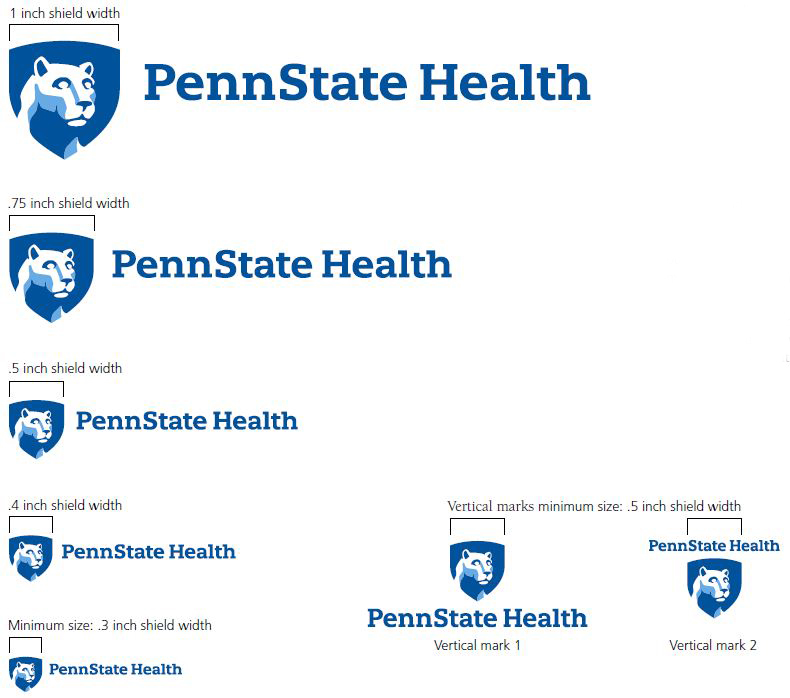
The horizontal mark with two colors, as shown below, is the primary mark and is used in the majority
of applications. Special-use marks have an important but limited use.
The special-use marks shown below are used only on our products and merchandise. These items are often seen outside the context of Penn State and use the ® (registration mark) to provide legal protection.
Other uses, such as stationery, marketing materials, presentations, signs, and digital applications, are not required to, and should not, use the marks with ®.
Trademark designations are required for items that bear the Penn State Health mark and are for commercial use. Please contact licensing@psu.edu for questions related to Penn State merchandise.
The placement of the ® is only used in conjunction with the Penn State Health logotype, never with the shield.
The ® may be used with special-use marks, such as one color without screens.
The entity marks for the hospitals, health system, campuses, colleges and administrative/academic units do not have vertical marks. The marks should not be reconfigured as vertical marks.
Never redraw or try to recreate the mark, including the shield or logotype. Any modification of the mark diminishes its impact and weakens our legal protection. Only authorized artwork may be used.

Careful placement of the mark is essential to correctly identify our organization’s communications. We want to avoid placement that seems arbitrary or indecisive. The alignments shown to the left have been used on our initial applications. The same alignment principles can apply to typography, imagery or graphic shapes. Aligning provides a sense of order and structure to the design.
The principles demonstrated here apply to the college, campus and administrative or academic unit marks.
It is not essential to use these alignment principles for all work. The key is to be aware of the importance of the placement of elements with the mark. Avoid situations where alignment is closely but not quite aligned, as this can appear to be a mistake.
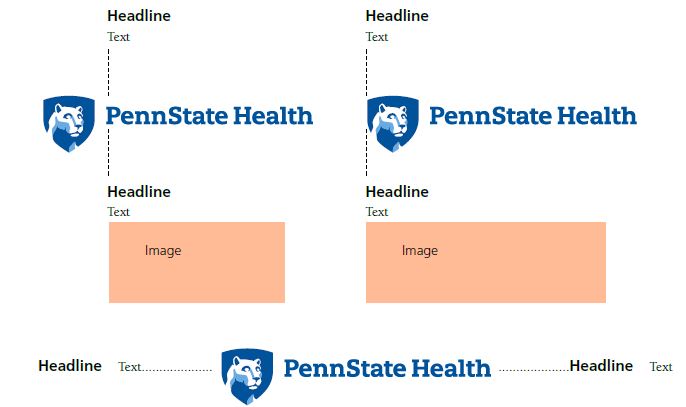
The mark can be used on both light and dark photographs. This use is possible because of the white outline around the shield, which provides a separation from the background and prevents common conflicts between marks and backgrounds with similar values or hues.
- Light backgrounds: use positive mark with the blue logotype
- Dark backgrounds: use reverse mark with the white logotype

This page demonstrates the ways in which marks are often misused. The incorrect use of a mark tends to give license to, and spawn, other misuses.
Never redraw or try to recreate the mark, including the shield or logotype. Any modification of the mark diminishes its impact and weakens our legal protection. Only authorized artwork may be used.
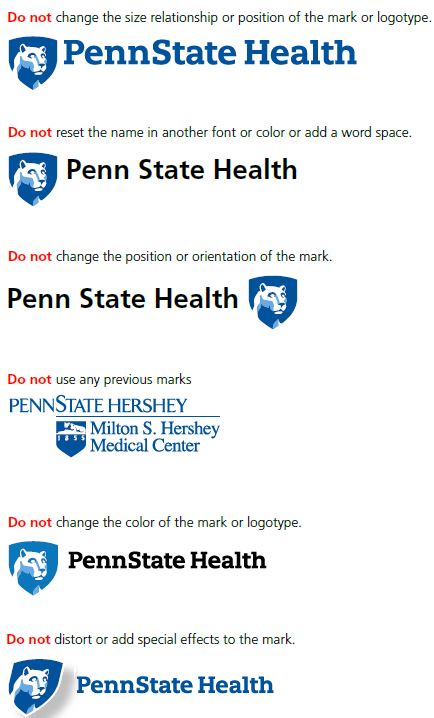
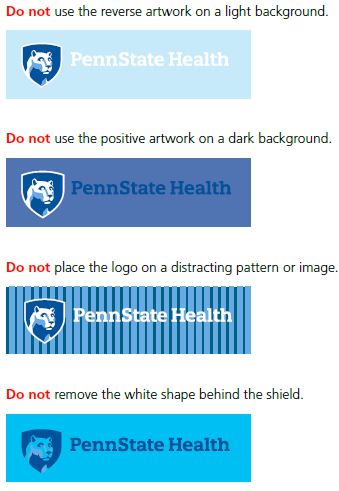
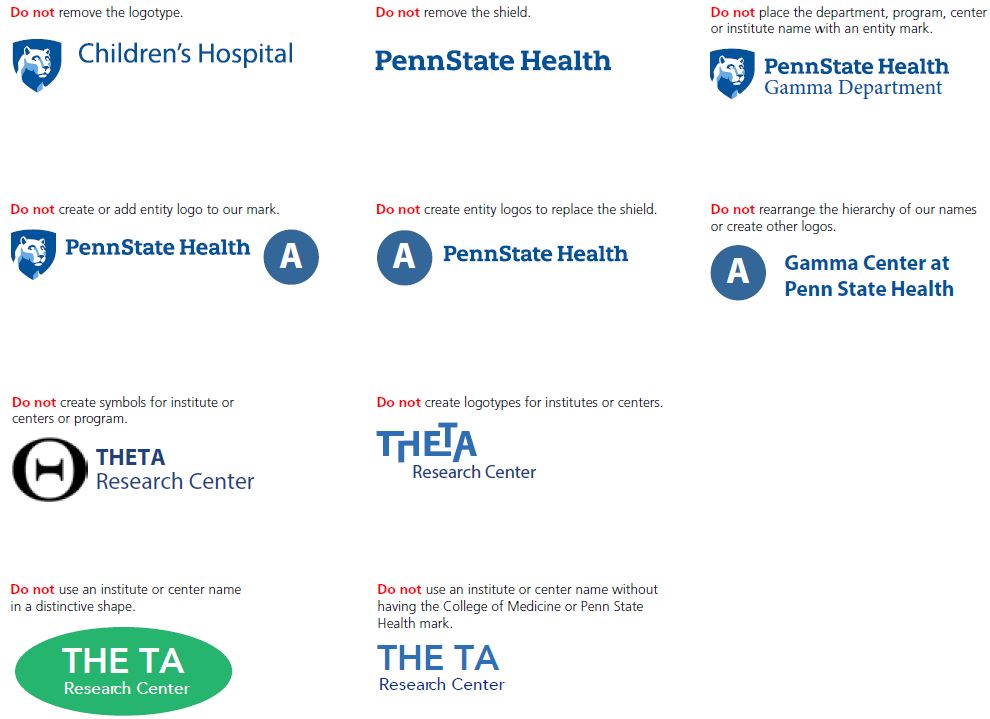

The Penn State Intercollegiate Athletics mark, featuring an oval-shaped, stylized side view of the head of the Nittany Lion statue, is relegated to the promotion of Penn State athletics and sports programs. The Athletics mark may be utilized to promote Penn State Sports Medicine and Penn State Bone and Joint Institute. This mark must be used with the Penn State Health Milton S. Hershey Medical Center mark and the official designation phrase: “The Official Healthcare Provider of Penn State Athletics” or “The Official Healthcare Provider of Penn State Football.” This phrase can be used without the Athletics mark. However, the Penn State Health Milton S. Hershey Medical Center mark must be placed before the phrase. The use of the mark and the official designation phrase must be pre-approved by the Office of Marketing and Communications and Penn State Sports Properties.
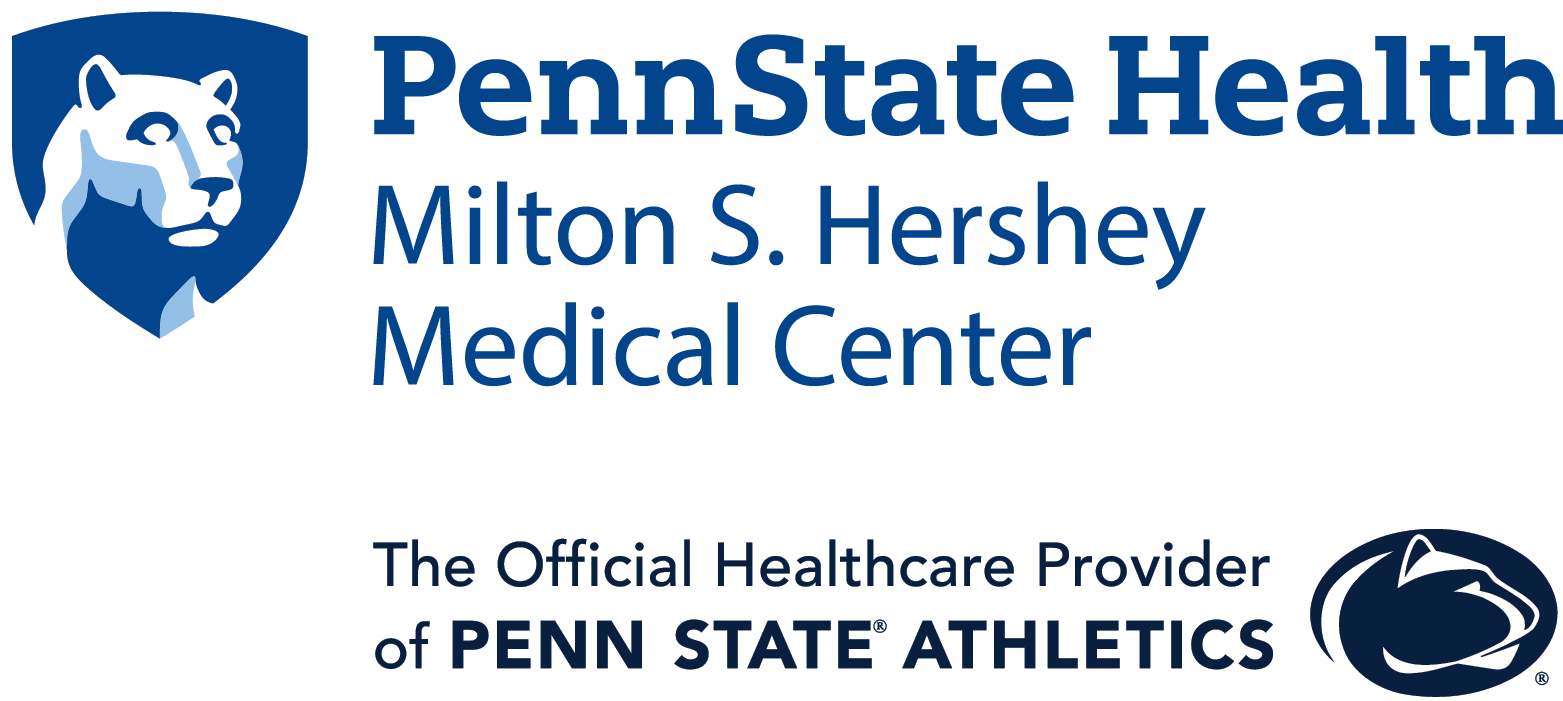
The Athletics mark may not be used to represent academic or administrative units of the University, hospitals, administrative units, institutes, centers, departments or degree-conferring units of Penn State Health or Penn State College of Medicine.

Having earned Magnet Recognition, Penn State Health is entitled to use the Magnet logo in promoting its clinical services. The Magnet logo should be used alongside the Milton S. Hershey Medical Center mark as a recognizable symbol of nursing excellence. The Magnet logo must be placed to the right of the Milton S. Hershey mark and no closer than half the width of the shield. Magnet marketing toolkit and the logo guidelines can be found on the American Nurses Credentialing Center website www.nursingworld.org/ancc.
The Magnet logo should not be used with Penn State College of Medicine or any hospital within Penn State Health that has not earned official Magnet recognition. The Magnet logo may be used so long as the Medical Center maintains its Magnet accreditation.

When Penn State Health, Penn State College of Medicine or other internal entity collaborates with entities outside Penn State Health, our entity’s logo may be placed alongside the partner logos, retaining the appropriate clear space. When multiple Penn State Health entities collaborate with entities outside Penn State Health, the Penn State Health logo should be used and may be placed alongside the partner logos, maintaining the appropriate clear space.


Sometimes, Penn State Health Children’s Hospital will endorse a partner organization such as Children’s Miracle Network or Four Diamonds. When the two entities’ logos appear together, the second organization’s logo should always be sized smaller than the Children’s Hospital logo unless it is used in an instance of co-branding in which the Children’s Hospital and the second organization are equal partners. The secondary logo may not be altered in any way.
In terms of placement, the secondary logo must be no closer to the Penn State Health Children’s Hospital mark than a minimum of .25 the width of the shield, a .5 width is preferred.


This paw print may be used as an additional graphic element for Penn State Health Children’s Hospital materials. It must be rendered as a four-toed paw and should only be reproduced using master artwork provided by the Office of Marketing and Communications. The paw print may be used independent of the Penn State Health Children’s Hospital mark but should never be presented as the Children’s Hospital logo.
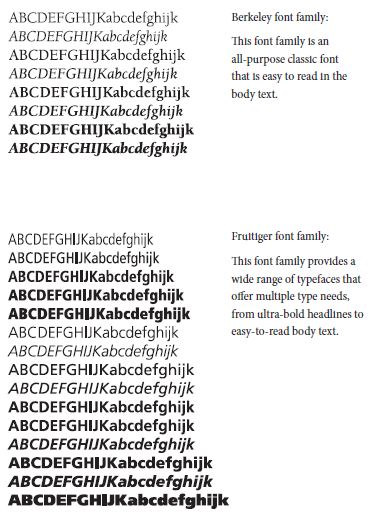
Typography is an essential component of the brand identity. Used consistently and effectively, typography distinguishes and adds personality to communications, in addition to ensuring legibility.
For most print applications, we use Berkeley and Fruitiger font families. Fruitiger font is the recommended sans serif font for use in print communications. Berkeley font is a classic serif with a large x-height in the lowercase letters.
If Fruitiger and Berkeley fonts are not available in your system, you may use Garamond and Trebuchet, respectively, as a substitute. All professional designers should use Fruitiger and Berkeley.
For our marks, we use custom typefaces that are not available for other uses.
Type families for web use
Roboto Sans is Penn State Health’s choice of font for the Web. This is controlled by the enterprise web portal for consistency across all web pages.

Verdana is Penn State Health’s choice of font for online and digital use. This is controlled by the enterprise web platforms for consistency across all webpages.
Berkeley font family: This font family is an all-purpose classic font that is easy to read in the body text.
Frutiger font family: This font family provides a wide range of typefaces that offer multiple type needs, from ultra-bold headlines to easy-to-read body text.

Roboto Sans is Penn State Health’s choice of font for the Web. This is controlled by the enterprise web portal for consistency across all web pages.

This gallery provides examples of work that not only adheres to the visual identity standards but is also strong, creative and effective. The Penn State Health homepage uses the mark large, with clear space around it.
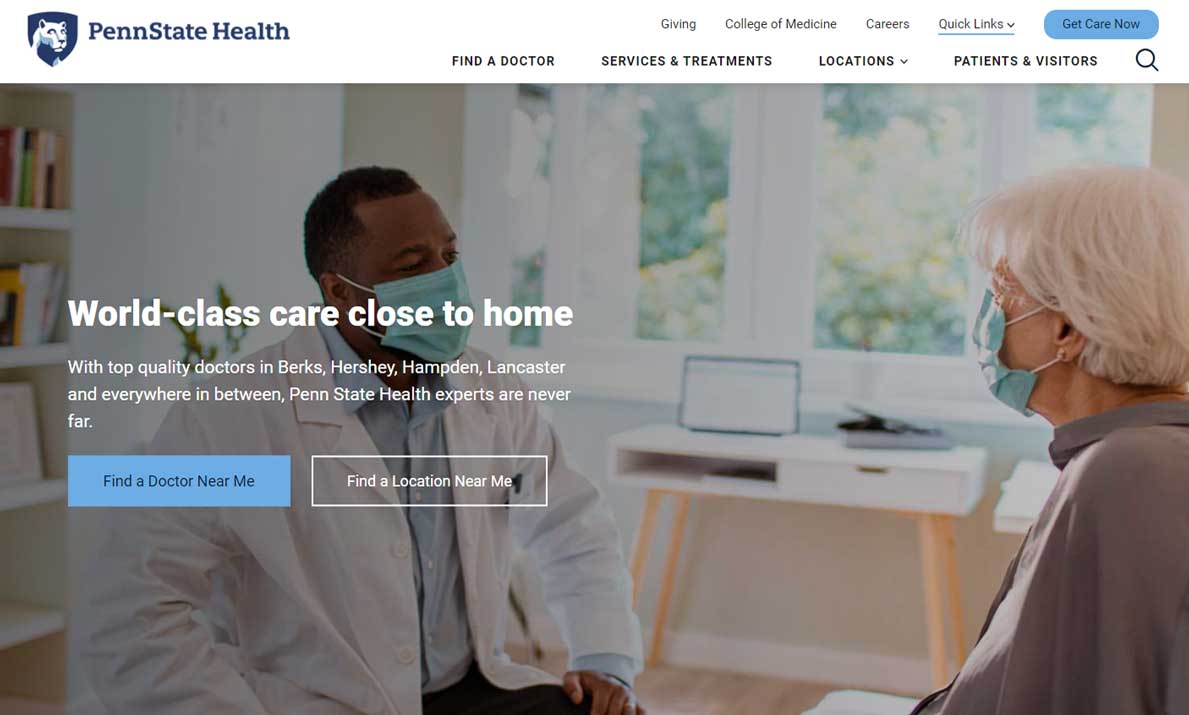
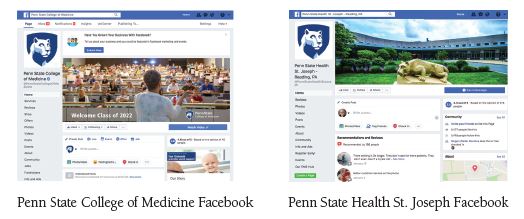
This image of a mug demonstrates how the vertical mark can be used. The focus on the large graphic image of the shield works well here, while still keeping our name visible.
Trademark designations are required for items that bear the Penn State Health mark and are for commercial use. Please contact the Office of Marketing and Communications for questions related to Penn State Health or Penn State College of Medicine merchandise.
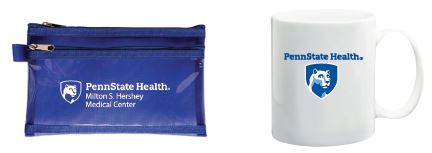
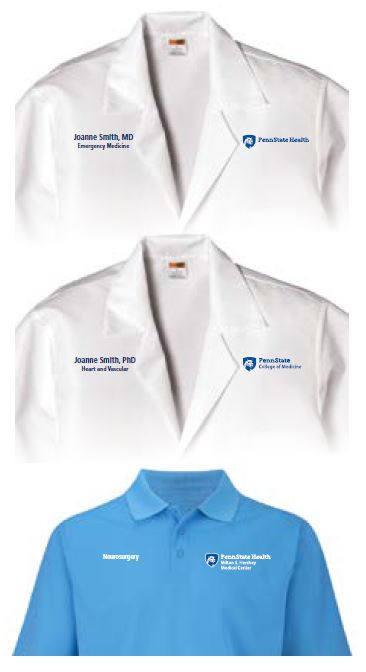
All uniform apparel shall carry the Penn State Health or Penn State College of Medicine mark on the left chest. These items include, but are not limited to, lab coats, scrubs, polo shirts and jackets.
The unit name will appear embroidered on the right breast of the uniform. The name and title of the individual may be embroidered on the left breast of the uniform, if required.
For quality assurance and compliance purposes, all official uniform apparel must be produced in coordination with the Medical Center’s Linen Services. Penn State Health and Penn State College of Medicine employees and faculty may order online through the Linen Services page of the Infonet: infonet.pennstatehershey.net/web/linen/home. This link is available to Penn State Health and Penn State College of Medicine employees and faculty only. All others should call Linen Services at 717-531-8320.
To present a consistent image for Penn State Health and Penn State College of Medicine, all departments and offices will use the official letterhead, envelopes and business cards. Tier 1 and 2 marks can be on the stationery. Tier 3, that is composed of the entity name, must be referenced above the address area. All stationery must be ordered through Penn State Health Printing Services, which is responsible for the consistent application of the stationery formats. To order, access the Penn State Health Printing Services Digital StoreFront at psh.myprintdesk.net/dsf.
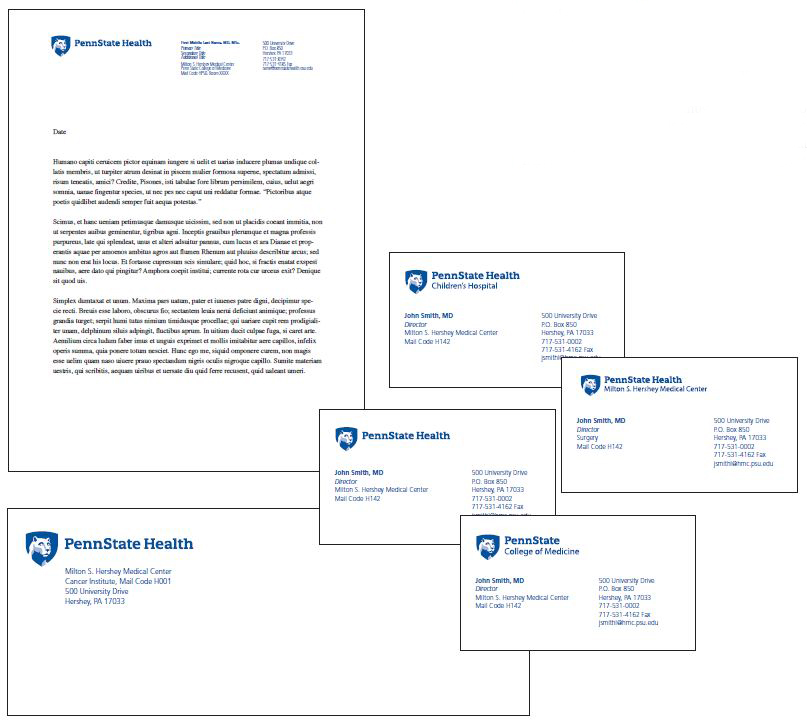
Design System Components
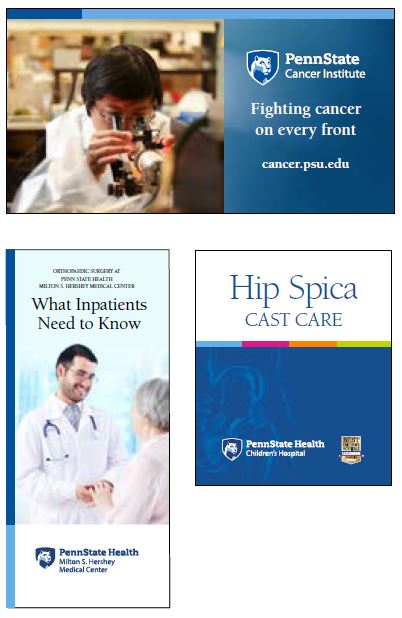 The Penn State Health design system has been developed to help reinforce the brand. It creates a consistent appearance for all our communications, and helps people differentiate our materials from other organizations’ materials.
The Penn State Health design system has been developed to help reinforce the brand. It creates a consistent appearance for all our communications, and helps people differentiate our materials from other organizations’ materials.
The examples on the right show the flexibility of the design system in context.
For printed materials, the logo should be positioned at the bottom of the first viewable surface. The approximate size of the logo on the brochure cover is 2 inches wide.
The connected line elements below are unifying graphic lines that should be incorporated in all Penn State Health materials. On a typical brochure or a one-sheet document, the approximate line weight is 15 points. On our websites the lines can be used as a navigation bar or can be incorporated into an image or content. The linear element can be positioned vertically or horizontally.
Writing Style and Web Guidelines
The Office of Marketing and Communications uses Associated Press style to maintain consistent content that presents a positive image of Penn State Health and Penn State College of Medicine.
The Associated Press Stylebook provides an A-Z guide to issues such as capitalization, abbreviation, punctuation, spelling, numerals and many other questions of language usage.
The Office of Marketing and Communications maintains images for use on Penn State Health and Penn State College of Medicine websites. All contents and images are protected by copyright and are the exclusive property of Penn State Health or Penn State College of Medicine. Vendors and others wishing to use any Penn State Health or College of Medicine images must receive prior approval from the Office of Marketing and Communications by calling 717-531-8606 or emailing Marketing&Communications@pennstatehealth.psu.edu Images from the online health library are provided by a vendor service and may be used on our webpages without any alteration.
The use of downloadable PDF documents is common from a website. Any PDF document that will be downloadable from our website should be identified as a Penn State Health or Penn State College of Medicine document by including, at a minimum, an approved mark. It is also advisable to indicate the date of publication and copyright reference. Providing alterable documents (such as Word, Excel and PowerPoint) not converted to PDF format is risky and should be avoided. Including a proper mark, date of publication and copyright reference before converting documents to PDF format is strongly encouraged. Use of downloadable documents limits the ability of website visitors using mobile devices to view or use these documents and is not generally compliant with policies ensuring accessibility to people with disabilities. Informational documents should be published as webpages whenever possible.
All online publishing for Penn State Health and Penn State College of Medicine websites is managed by Web Solutions or designated parties at other entities. Requests for online content updates, including video, should be directed to Web and Digital Services.
Third-party advertising or commercial promotion is not permitted on Penn State Health and Penn State College of Medicine domains. All websites on the Penn State Health and Penn State College of Medicine domains must comply with the organization’s legal and copyright statement.
Requests to make use of Penn State Health and Penn State College of Medicine name and images may be received from organizations, businesses and groups not affiliated with Penn State, Penn State Health or Penn State College of Medicine. Such requests may be made in connection with consumer products or services, fundraising, sponsorship of activities, advertising, marketing or for other purposes.
All requests must be submitted to and approved by the chief marketing officer in consultation with the University Licensing Programs Office and, in some circumstances, Penn State Health’s legal counsel. If approved, a written license agreement with the organization or group will be required. In some instances, payment of a royalty fee may be required, if such use is approved. Approval for using the Penn State Health and College of Medicine names and marks is at the sole and unrestricted discretion of Penn State Health and the College of Medicine. Usage, in this regard, pertains to consumer products, fundraising, corporate sponsors, local businesses, news and media services.
Penn State Health and Penn State College of Medicine’s names and images cannot be used by or on behalf of a political candidate, political party, political action committee or a committee formed to support a political candidate.
Before using Penn State Health and Penn State College of Medicine’s names and images, it is important to consider whether the use would be supportive of Penn State Health and the College of Medicine’s missions, reputations and values.
As you consider specific situations, ask yourself whether the use of Penn State Health and Penn State College of Medicine’s name and marks would accomplish the following:
- support Penn State Health and Penn State College of Medicine’s missions of patient care, research, education and community engagement.
- reflect Penn State Health and Penn State College of Medicine’s commitment to the values of honesty, integrity and compassion.
- preserve Penn State Health and Penn State College of Medicine’s reputations as recognized leaders in health research and services to the community.
- be in compliance with Penn State Health and Penn State College of Medicine’s policies and codes of conduct.
- show respect for people, particularly physicians, nurses, employees, faculty members and students.
Penn State Health and Penn State College of Medicine Writing Style Guide - Naming and Nomenclature Guidelines
Penn State Health – references the health system (see Boilerplate for details)
- “the health system” may be used on subsequent references if it is the only health system mentioned in a piece of copy
- Should never be shortened on subsequent references
- Should not be abbreviated (see Acronyms)
Penn State Health Milton S. Hershey Medical Center
External audience:
- Penn State Health Milton S. Hershey Medical Center ─ first reference
- Milton S. Hershey Medical Center ─ second and subsequent references. “The” is not needed before the name. This legal name gives proper credit to the original 1963 deeded gift that created the Hershey campus and must always be used when referring to operations at the original Hershey campus, including activities of Penn State College of Medicine. The Milton S. Hershey Medical Center name is used in contracts, legal documents and as required by the Articles of Trust for the Milton S. Hershey Medical Center. “Penn State Health Milton S. Hershey Medical Center” is also acceptable as a legal name.
- Avoid using “Medical Center” by itself because Penn State Health has five different medical centers.
Internal audience:
- Milton S. Hershey Medical Center ─ first reference
- Hershey Medical Center – second and subsequent references
- For internal communications that refer only to Hershey Medical Center, it is acceptable to use “Medical Center” on the second or third reference. “Medical Center” should be capitalized.
External and internal audiences:
- Never use:
- Penn State Hershey
- Hershey Med
- Hershey
Penn State Hampden Medical Center
- Penn State Health Hampden Medical Center – first reference
- Hampden Medical Center – subsequent references
- Never use “Hampden”.
Penn State Health Holy Spirit Medical Center
- Penn State Health Holy Spirit Medical Center – first reference
- Holy Spirit Medical Center – subsequent references
- Never use “Holy”.
Penn State Health Lancaster Medical Center
- Penn State Health Lancaster Medical Center – first reference
- Lancaster Medical Center – subsequent references
Penn State Health St. Joseph Medical Center
- Penn State Health St. Joseph Medical Center – first reference
- St. Joseph Medical Center – subsequent references
- Never use “St. Joe’s.”
- Never use “Penn State Health St. Joseph.” That previously referred to the St. Joseph health system before the outpatient practices became part of Penn State Health Medical Group, Community Practice Division. If referencing the hospital and outpatient sites, say: “Penn State Health St. Joseph Medical Center and outpatient locations in the Berks Region.”
Penn State Health Children’s Hospital – first reference
- the Children’s Hospital – subsequent references
Penn State Health Children’s Lancaster Pediatric Center – first reference
Penn State Health Rehabilitation Hospital
Penn State Health Medical Group
- Outpatient practices associated with Penn State Health are considered part of Penn State Health Medical Group. The Medical Group name refers to the overall collection of practices, as well as the individual practices. Each individual practice is referenced with a specific site identifier. Use an en dash before the site identifier with a space before and after the en dash. The Medical Group name and location identifier does not reflect services offered there.
- Example: Penn State Health Medical Group – Benner Pike
Penn State Health Medical Group – Academic and Community Practice Divisions
Do not use the following names:
- Penn State Health Medical Group, Academic Practice Division
- Academic Medical Group
- Penn State Health Medical Group, Community Practice Division
- Community Medical Group
All Community Practice Division locations should simply be called:
- Penn State Health Medical Group
All Academic Practice Division locations should be called:
- The outpatient practices affiliated with the Milton S. Hershey Medical Center
Or
The Milton S. Hershey Medical Center and its affiliated outpatient practice sites.
Medical Group – former St. Joseph outpatient locations
- Locations that formerly had “Penn State Health St. Joseph” in the name because they provide hospital-based services are no longer designated with that prefix because St. Joseph no longer has a legal requirement to communicate which of its locations or services are hospital-based. These outpatient locations are now part of the Penn State Health Medical Group. Their names begin with “Penn State Health Medical Group,” followed by an en dash with a space before and after it, and the location name.
- Example: Penn State Health Medical Group – Robesonia
Children’s Miracle Network
- No “The” before Children’s Miracle Network
- Children’s Miracle Network at Penn State Health Children’s Hospital on first reference; CMN on subsequent reference
- The annual fundraising event called “telethon” is lowercased when not used together with the formal organization name.
Four Diamonds
- NOT Four Diamonds Fund
Penn State – first reference
- NOT Penn State University
- The University – subsequent references. “The” does not need to be capitalized.
- The Pennsylvania State University is reserved for formal or legal documents (diplomas, contracts, etc.)
- Capitalize “The” when used as part of the University’s full name: The Pennsylvania State University
Penn State College of Medicine – first reference
- Penn State College of Medicine University Park Curriculum is exempt from this reference.
- College of Medicine – subsequent references
- Do not use formal first references of organization names for internal use, unless it is necessary for clarity. Instead of the formal name, use “College of Medicine.”
Single Specialty Practices
- Single specialty practice names should begin with the master brand “Penn State Health” as the prefix, followed by the service name, with no en dash in between.
- Example:
- Penn State Health Pain Medicine
Milton S. Hershey Medical Center
University Physician Center
(address)
- Penn State Health Pain Medicine
- Example:
Single Specialty Practices within a Building Not Owned by Penn State Health
- Penn State Health practices that have several specialties in different suites within a building that is not owned by Penn State Health should be identified as “Penn State Health (service).”
- Example:
- Penn State Health Diabetes Management at Spring Ridge Outpatient Center, 2607 Keiser Blvd., Wyomissing
- This building houses family practice, diabetes management, lab services, imaging services and physical therapy.
- Example:
First reference:
- Penn State Health Milton S. Hershey Medical Center (for external audience)
- Milton S. Hershey Medical Center (for internal audience)
- Penn State College of Medicine
- Penn State Health Hampden Medical Center
- Penn State Health Holy Spirit Medical Center
- Penn State Health Lancaster Medical Center
- Penn State Health St. Joseph Medical Center
- Penn State Health Children’s Hospital
- Penn State Health Children’s Lancaster Pediatric Center
- Penn State Health Medical Group
- Penn State Bone and Joint Institute
- Penn State Cancer Institute
- Penn State Clinical and Translational Science Institute
- Penn State Heart and Vascular Institute (do not use ampersand)
- Penn State Institute for Personalized Medicine
- Penn State Melanoma Center
- Penn State Neuroscience Institute
- Penn State Stroke Center
Second reference:
- Milton S. Hershey Medical Center (for external audience)
- Hershey Medical Center (for internal audience)
- the College of Medicine; the College
- Hampden Medical Center
- Holy Spirit Medical Center
- Lancaster Medical Center
- St. Joseph Medical Center
- the health system
- the Cancer Institute
- the Children’s Hospital
- the Heart and Vascular Institute
Third reference:
- the Medical Center (for internal audience. “The” should not be capitalized.)
When referencing more than one Penn State Health or Penn State College of Medicine entity in the same sentence, the master brand is used only once. The order of priority is as follows: the health system, medical centers and the College of Medicine. After that, entities should be shown alphabetically. Hospitals and institutes rank above centers, the Medical Group, departments, divisions and services.
Examples:
- Penn State Health and Penn State College of Medicine
- Penn State Health and the College of Medicine
- Penn State Health and Milton S. Hershey Medical Center
- Penn State Health, Milton S. Hershey Medical Center and Penn State College of Medicine
- Penn State Health Milton S. Hershey Medical Center and Penn State Health Children’s Hospital
- Penn State Cancer Institute and Penn State Health Children’s Hospital
- Penn State Health Children’s Hospital and Orthopaedics
Joint ventures
Penn State Health is engaged in joint venture initiatives with external partners. Because the multiple brand names of all parties involved in these joint ventures may require a specific naming solution, nomenclature guidelines for these situations will be handled on a case-by-case basis.
People
Full name, credentials on first reference
Example: Sharon Silver, MD
Associated Press Stylebook recommends minimizing use of credentials when possible
- Dr. Sharon Silver – to the layperson, the title “Dr.” means a medical degree, whether MD, DO, etc, so generally, “Dr.” should not be used for PhDs or others who hold a doctorate.
- Sharon Silver, a licensed practical nurse, …
- Sharon Silver, who holds a PhD in engineering, …
- Use last name only on second reference: “Silver said she thought, ….” In some internal memos and publications, using the title “Dr.” with the last name is appropriate
For internal memos that are more personal in nature, using a person’s first name on subsequent references is acceptable:
- Please join me in welcoming Marie to Penn State Health.
Do not include employee’s middle initial unless the employee specifically requests it.
Leadership titles
Refer to the following:
Quick Reference: Penn State Health Writing Style
- Do not use serial/Oxford comma.
- In external-facing content, avoid using first-person plural pronouns such as “We” and “Our” and second-person pronouns such as “You” and “Yours.” Instead, use a more formal style such as “The medical center was honored with an award.”
- In internal-facing content, first-person plural and second-person pronouns are acceptable.
- Do not use “will be held” or “was held.” Instead, say “will take place” or “took place,” or “is scheduled on.”
- On vs. for:
- Examples:
- Staff nurse for the Nursing Vascular Access team – not “Staff nurse on the Nursing Vascular Access team.”
- Examples:
- Chair: Use chair, not chairman or chairwoman.
- Chair of the Department of Biochemistry and Molecular Biology at Penn State College of Medicine.
- Avoid using abbreviations and acronyms, which can lead to confusing, unclear and inefficient communication. Exceptions are for clarity ─ when the audience is more familiar with the abbreviation or acronym than the full name ─ and when space or time is critically limited.
- Examples: CDC, NASA, USA, RITE values
- Spell out the full name on first reference, then use the entity on second reference:
- Examples:
- First reference: College of Medicine.
- Second reference: The College…
- First reference: National Institutes of Health
- Second reference: The Institute…
- Examples:
- If an acronym is necessary, spell out the full name and put the acronym in parentheses.
- Example: Patients with sleep apnea may use a continuous positive airway pressure (CPAP) device.
- It is no longer required for an acronym to appear at least twice in an article before the acronym can be used.
- For internal-facing content, acronyms are acceptable if the audience is likely to be familiar with them.
- Abbreviations and acronyms may also be used for clinical communication systems and emergency alerting.
- In memos and other internal communication materials, use full names to refer to units or entities within the health system and College of Medicine in order to avoid confusion. Avoid using acronyms.
- While this practice is acceptable for internal purposes, abbreviations should never be used to publicly reference any Penn State Health or College of Medicine entity.
- Avoid using the acronym ED. Instead, use emergency department.
- Entity names should not be truncated to acronym form unless space is limited, such as on an electronic form. The acronym should be clearly spelled out up front.
- Common Penn State Health acronyms:
- CHI (Children’s Hospital)
- COM (College of Medicine)
- HAMC (Hampden Medical Center)
- HMC (Hershey Medical Center)
- HSMC (Holy Spirit Medical Center)
- LMC (Lancaster Medical Center)
- LPC (Lancaster Pediatric Center)
- MG (Medical Group)
- MSHMC (Milton S. Hershey Medical Center)
- PSHMG (Penn State Health Medical Group)
- STJ (St. Joseph)
- Common Penn State Health acronyms:
- Building and location names should be spelled out to avoid confusion among employees, patients and visitors.
- Examples:
- Academic Support Building (avoid ASB)
- University Physician Center (avoid UPC)
- St. Joseph Medical Office Building (avoid MOB)
- Examples:
- Milton S. Hershey Medical Center should be described as an academic medical center and the hub of an integrated academic health system, Penn State Health. It is the only locally based academic medical center in central Pennsylvania. Academic medical centers provide a higher level of specialized care with more advanced and complex procedures and treatments. They also provide training to medical students, medical residents and fellows, and other learners.
- Penn State Health is an integrated academic health system. It provides primary, specialty and urgent care, as well as highly advanced, specialized care for patients with complex or life-threatening conditions—all within the health system.
Do not use the following names:
- Penn State Health Medical Group, Academic Practice Division
- Academic Medical Group
- Penn State Health Medical Group, Community Practice Division
- Community Medical Group
All Community Practice Division locations should simply be called:
Penn State Health Medical Group
All Academic Practice Division locations should be called:
The outpatient practices affiliated with the Milton S. Hershey Medical Center
Or
The Milton S. Hershey Medical Center and its affiliated outpatient practice sites.
Use accent marks per Webster’s New World College Dictionary.
Example: The name Cézanne is written with an acute accent mark.
- Link text should describe the link destination instead of “click here” or “read more.” For example, instead of:
- Click here for instructions on how to use the new Penn State web tool.
- Write:
- Instructions for the new Penn State web tool are available online.
- Learn more on the Penn State Accessibility website.
- See more accessibility information and resources on the World Wide Web Consortium.
- Use the abbreviations Ave., Blvd. and St. only with a numbered address: 1600 Pennsylvania Ave.
- Spell them out and capitalize when part of a formal street name without a number: Pennsylvania Avenue.
- List 30 Hope Drive and 35 Hope Drive on the Hershey campus as follows:
Penn State Health Milton S. Hershey Medical Center
30 Hope Drive
East Health Campus
Entrance B, Suite 2200
Hershey, PA - When noting entrances and suite numbers, put the entrance first, then the suite number.
- List Penn State Health St. Joseph Medical Office Building as follows:
Penn State Health St. Joseph
Medical Office Building
2494 Bernville Road, Suite 103
Reading, PA 19605
Advanced practice providers (APP) include physician assistants and advanced practice registered nurses. Do not refer to them as advanced practice clinicians (APC).
- Alternative (alt) text is descriptive text that enables users who are sight-impaired to identify an image. It should be included with all images.
- Alt text should be concise (about 125 characters) and include information that is useful in the context of the article. For example, alt text for an image in a consumer-facing article could read:
- Transplant recipient Daniel Diaz-Hernandez has physical therapy with nurse Ashley Banks, left, and therapist Courtney Machamer.
- Alt text for the same image aimed at a clinical audience can provide more detailed information:
- Transplant recipient Daniel Diaz-Hernandez performs supervised cardiac rehabilitation during a physical therapy session with registered nurse Ashley Banks, left, and therapist Courtney Machamer at Penn State Health Milton S. Hershey Medical Center.
- See Appendix A on this page for instructions on how to write alt text. For accessibility guidelines, refer to Penn State accessibility guidelines.
Use a hyphen between the following:
- Board-certified physician
- …she is board-certified.
The following acronyms are used for buildings on the Hershey Medical Center campus:
- H – hospital – Hershey Medical Center
- C – College
- P – Children’s Hospital
- MB – Main Building (hospital and college)
- T – Cancer Institute
- ASB – Academic Support Building
- BMR – Biomedical Research Center
- UPC – University Physician Center
- UFC – University Fitness Center
Insert a comma between a building location and room number.
Example:
- Junker Auditorium, Room HG316
- Make bullet points consistent in structure – all sentences or all fragments.
- Capitalize the first word of each bullet point unless it is a continuation of a sentence.
- Example: See your doctor for the best:
- advice
- treatment
- follow-up care
- Example: See your doctor for the best:
- Use periods, not semicolons, at the end of each section, whether it is a full sentence or a phrase, as stated in the AP Stylebook
- Example: Advocating for your care begins with effective communication:
- Understand the roles of the care team members – and that you have a right to ask why someone is in your room.
- Ask questions until you fully understand the plan of care.
- Attend rounds, during which the attending doctor, residents, medical students and nurses meet to discuss your condition and give you an update.
- Example: Advocating for your care begins with effective communication:
- Avoid using transition words and phrases such as “secondly” or “another point.”
- Use the latest versions of Webster’s Collegiate Dictionary and the AP Stylebook to check on capitalization of non-Penn State-related words.
- Do not capitalize academic titles unless the title appears before a person’s name. Initial-capped academic titles are acceptable in certain instances of correspondence or formal invitations.
CAR T-cell therapy, a form of immunotherapy for blood cancer, is spelled as follows:
- 1st reference: chimeric antigen receptor (CAR) T-cell therapy
- 2nd reference: CAR T-cell therapy
- 3rd reference: CAR T
Related words:
- CAR T cells
- T cells
Penn State Health’s CareLine is one word.
Center
- A center at Penn State Health is a multispecialty practice that provide diagnosis, management and specialized treatment for one disease or condition in one location. It differs from an institute by not performing research or following university requirements to be designated an institute
- Its name includes the master brand “Penn State Health,” followed by the program name and “Center.” No en dash is needed between the program name and service. First reference: use full center name. Second reference: the center.
- Example: Penn State Health Breast Center
- See Penn State College of Medicine centers.
Clinic
A clinic at Penn State Health is a department within a medical center, institute or practice that provides specialty care for a disease or condition.
- Example:
- Penn State Health Milton S. Hershey Medical Center ─ ALS Clinic
- Minimize use of the word “clinic” when referring to Penn State Health locations because it has the connotation of a walk-in clinic or free clinic. Instead, use “practice” or “program.”
- Examples:
- Outpatient practice
- Fatty Liver Disease Program
- Examples:
Department
- A department is a group of medical staff in a health system that provides a specific type of medical diagnosis or treatment or a separate functional area within an organization that provides a specific set of services.
- Generally speaking, departments, divisions or sections should not be combined with the Penn State Health master brand because they are aligned with the medical center or college rather than the health system as a whole. It is not necessary to use “Department, “Office” or “Program” as part of the name, especially for external audiences, who are focused on our services, not our structure.
- Examples:
- Preferred construction: Neurosurgery at Penn State Health Milton S. Hershey Medical Center
- Alternate construction: The Department of Neurosurgery at Penn State Health Milton S. Hershey Medical Center
- Preferred construction: Facilities at Penn State Health Milton S. Hershey Medical Center
- Alternate construction: The Department of Facilities at Penn State Health Milton S. Hershey Medical Center
- Examples:
- Capitalize departments only when using their formal, official name.
- Examples:
- Department of Surgery vs. surgery department or surgery
- Division of Artificial Organs vs. artificial organs division
- Examples:
- Do not use “Department” in Penn State Health department names. The service name itself is sufficient.
- Examples:
- Finance
- Security
- Human Resources
- Examples:
- Be careful not to confuse department and division.
- Example:
- Department of Medicine vs. Division of Internal Medicine
- Example:
- See Penn State College of Medicine departments
Diagnostic Centers (Freestanding Diagnostic Services)
- Freestanding outpatient services are clinical services that are not located within a Medical Group site or outpatient center. They include ancillary services such as lab and imaging services. Their names begin with the master brand “Penn State Health,” followed by the service name, an en dash and the location name.
- Example:
- Penn State Health Diagnostic Center – Union Deposit
4520 Union Deposit Road
Harrisburg, PA
- Penn State Health Diagnostic Center – Union Deposit
- Example:
Division
A division is a larger organization unit made up of multiple departments at a health system.
Institute
- An institute at Penn State Health is a location that offers all aspects of care for a particular disease or condition, including patient education, prevention, diagnosis, treatment and research, in one location. Because institutes are affiliated with Penn State and must pass rigorous university requirements in order to be designated an institute, their names begin with “Penn State,” rather than the master brand “Penn State Health,” followed by the program name and “Institute.” First reference: use full institute name. Second reference: the institute.
- Examples:
- Penn State Cancer Institute
- Penn State Heart and Vascular Institute
- Examples:
- See Penn State College of Medicine institutes.
Practice
- A practice is an institution that provides medical care to patients.
- Single specialty practice names should begin with the master brand “Penn State Health” as the prefix, followed by the service name, with no en dash in between.
- Example:
- Penn State Health Pain Medicine
Milton S. Hershey Medical Center
University Physician Center
(address)
- Penn State Health Pain Medicine
- Example:
- Penn State Health practices that have several specialties in different suites within a building that is not owned by Penn State Health should be identified as “Penn State Health (service).”
- Example:
- Penn State Health Diabetes Management
Spring Ridge Outpatient Center
- Penn State Health Diabetes Management
- Example:
Program
A program is an activity that provides a specific type of health care services.
- Example:
- ALS Program
Service Line
- A service line is a specific grouping or population of “like” patients based on patient encounter attributes such as inpatient versus outpatient and major disease categories.
- Avoid the use of “service line” in external-facing communications. Instead, use “services.”
- All service line names have the brand name “Penn State Health” before the service.
- Examples:
Penn State Health Behavioral Health
Penn State Health Cancer Center at (medical center name)
Penn State Health Children’s
Penn State Health Gender Health
Penn State Health Heart and Vascular
Penn State Health Imaging Services (Note: not Radiology)
Penn State Health Infectious Diseases (plural)
Penn State Health Lab Services
Penn State Health Otolaryngology ─ Head and Neck Surgery
Penn State Health Women’s Health
- Examples:
In narrative copy use “central Pennsylvania.” In ad copy it is acceptable to use “Central PA.”
- For external-facing content, capitalize unit names like “Surgical Intensive Care Unit” and “Post-Anesthesia Care Unit”.
- For internal-facing content, acronyms are acceptable if the audience is likely to be familiar with them.
- Commencement is lowercase:
- Examples:
- spring commencement
- fall commencement
- Examples:
- Semester is lowercase:
- Examples:
- spring semester
- fall semester
- Examples:
- Avoid using “commonwealth” when referring to Pennsylvania. Instead, use “state.”
- If it’s necessary to use “the commonwealth,” make “the” and “commonwealth” lowercase.
Avoid using the word “comprised.” Instead, use “consists of,” “includes” or “is made up of.”
- When two or more counties are combined, make “counties” lowercase.
- Example: Cumberland and Dauphin counties.
- AP Stylebook recommends minimizing the use of credentials when possible.
- Do not use “MD” or “DO” after a physician’s name. Instead, use “Dr.” before the name. The only exceptions to this rule are internal memos and tabular materials, such as event programs, event articles, lists of award winners in an article and photo captions in grant award articles.
- To the layperson the title “Dr.” means a medical degree, so do not use “Dr.” for PhDs or others who hold a doctorate. Instead, use the individual’s title.
- Examples:
- Sharon Silver, who holds a PhD in engineering, …
- “…who holds a doctorate in engineering.”
- Do not use periods in degrees, including MD and PhD.
- Use physician’s last name only on second reference.
- Do not use credentials for nurses in most external-facing materials. This is consistent with Penn State style.
- Example: Sharon Silver, a licensed practical nurse, …
- Exceptions:
- Internal memos
- Publications
- News releases for science/trade journals
- Materials and articles aimed at a physician audience, including new provider marketing flyers, Medical Report articles and Doximity articles
- Tabular materials, such as lists of physicians in marketing materials, event programs, lists of award winners in an article and photo captions in grant award articles
Currency format: $35 (not $35.00).
- Abbreviate months according to AP Stylebook.
Example: The gym is extending its hours beginning Tuesday, Jan. 2.
- After an event occurs, use the date only, not the day of the week.
- Use comma after year in the middle of a sentence.
- Example:– On Jan. 23, 2019, Penn State…
- Do not start an article with the date at the beginning of the first sentence.
- When referencing a range of days, use an en dash with no space before or after in tabular materials such as flyers, signage and digital ads.
- Example: Monday–Thursday
- In narrative copy, use “to” or “through.”
- Examples:
- July 2 to 12
- Monday through Thursday
- Examples:
- Use day of week for dates that are in the future.
- Example: Wednesday, Feb. 6 for future date. Feb. 6 for past date.
- Always check that the day of the week is correct for the date.
- Generally speaking, departments, divisions or sections should not be combined with the Penn State Health master brand because they are aligned with the medical center or college rather than the health system as a whole. It is not necessary to use “Department, “Office” or “Program” as part of the name, especially for external audiences, who are focused on our services, not our structure.
- Examples:
- Preferred construction: Neurosurgery at Penn State Health Milton S. Hershey Medical Center
- Alternate construction: The Department of Neurosurgery at Penn State Health Milton S. Hershey Medical Center
- Preferred construction: Facilities at Penn State Health Milton S. Hershey Medical Center
- Alternate construction: The Department of Facilities at Penn State Health Milton S. Hershey Medical Center
- Preferred construction: Penn State College of Medicine Office of Medical Education
- Alternate construction: The Office of Medical Education at Penn State College of Medicine
- Preferred construction: Transplant at Penn State Health Milton S. Hershey Medical Center
- Alternate construction: The Transplant Program at Penn State Health Milton S. Hershey Medical Center
- Examples:
- Capitalize departments only when using their formal, official name.
- Examples:
- a professor in the Department of Radiology
- a professor of radiology (not capitalized)
- Department of Surgery vs. surgery department or surgery
- Division of Artificial Organs vs. artificial organs division
- Examples:
- Be careful not to confuse department and division.
- Example:
- Department of Medicine vs. Division of Internal Medicine
- Example:
Penn State Health’s Printing Services online portal for ordering print materials is called the Penn State Health Digital StoreFront.
- The correct the name of this department at Penn State Health is the Office for Diversity, Equity and Inclusion.
- The name of this department at Penn State College of Medicine is the Office of Diversity, Equity and Belonging.
- The DEI Office at Penn State Health uses the term” Latinx” to describe Latin American people or heritage. This differs from the AP Stylebook, which says:
Latinx should be confined to quotations, names of organizations or descriptions of individuals who request it and should be accompanied by a short explanation. “Hernandez prefers the gender-neutral term Latinx.”
Avoid using “East Health Campus” in addresses or marketing materials. The Milton S. Hershey Medical Center name and street address provide enough information to identify a practice’s location. Use the following address format:
Penn State Health Breast Center
Milton S. Hershey Medical Center
30 Hope Drive
Entrance A, Suite 1800
Hershey, PA 17033
One word
- When referring to the electronic medical record system, include the word “system.”
- “Electronic medical record” means an individual patient record.
Spell out, Do not abbreviate to ED.
- Endowed chair names are capitalized.
- Example: the William Pierce Endowed Chair
Esteem Penn State Health Cosmetic Associates
Do not use statements such as “best”, “most”, “top” etc., without attributing it to an individual in a quote or using qualifying language.
- Lowercase
- Example:
- The program is awaiting state and federal funding.
- Example:
Use a hyphen between the following:
- Fellowship-trained surgeon
- …she is fellowship-trained.
When citing sources in content intended for professional (not consumer) audiences, use the American Medical Association (AMA) citation style.
First, second- and third-person point of view:
- First-person pronouns: I, we, ours
- Second-person pronouns: you, yours, his, hers, its, theirs
- Use third-person in most narrative articles, clinical information and operational information.
- First- and second-person is acceptable for patient-focused materials.
- Direct-mail pieces can use a combination of first-, second- and third-person.
Health care is two words, in accordance with AP Stylebook.
Avoid using the word “held,” as in “A meeting will be held,” which is passive tense. Instead, use “will hold,” “presented,” “took place,” “is scheduled for” or other active verbs.
Do not refer to the Hershey campus as simply “the Hershey campus.” Instead, call it “the Milton S. Hershey Medical Center and Penn State College of Medicine campus in Hershey.”
- Use a hyphen between two or more words when they come before a noun that they modify and act as a single idea.
- Example:
- Patient-friendly service
- Example:
- Do not use a hyphen if the first word is an adverb (ends in -ly).
- Example:
- Newly formed committee
- Example:
- There are many examples of and exceptions to hyphenated words, so check the AP Stylebook.
Use “impact” as a noun only, not a verb.
Correct:
Your actions have an impact on the organization.
Incorrect:
You impact the organization.
The Inflammatory Bowel Disease (IBD) Center at 200 Campus Drive, Hershey, is named the Carlino Family IBD Center.
- Penn State Health is an integrated academic health system. It provides primary, specialty and urgent care, as well as highly advanced, specialized care for patients with complex or life-threatening conditions—all within the health system.
- Milton S. Hershey Medical Center is an academic medical center that is the hub of an integrated academic health system.
- Put job title after the person’s name.
- If a job title is before the person’s name, it should be lowercase.
- Make job titles lowercase.
- Exceptions:
- Announcements about promotions or executive hires
- Lists
- Below name in memos and emails and on business cards
- Exceptions:
- Roles are not job titles and should not be capitalized.
- Example:
- The nurse said (not the Nurse said
- Example:
- Do not include person’s middle initial.
- Do not use “VP.”
- Use “vice president of medical affairs,” not “for medical affairs.”
- Examples:
- The nurse said (not the Nurse said)
- The doctor told us to (not the Doctor told us to)
- The operator forwarded a call (not the Operator forwarded a call)
- Identify providers with the name of the hospital rather than the institute or center. For example, say “Dr. John Smith, a cardiologist at Penn State Health Milton S. Hershey Medical Center” rather than “Dr. John Smith, a cardiologist at Penn State Heart and Vascular Institute.
- When employees have both a clinical title and Penn State College of Medicine title, use the clinical title first:
- Example:
- Dr. Janet Smith, gastroenterologist at Penn State Health Milton S. Hershey Medical Center and associate professor at Penn State College of Medicine.
- Example:
Avoid using leaning words such as so, mostly, most times, in order to, often and oftentimes. They are not necessary
- Use “Penn State Health Lime Spring Outpatient Center” or “Lime Spring Outpatient Center” when referencing the building.
- Use “Penn State Health Medical Group – Lime Spring” when referencing the practice. This medical group is part of the Lime Spring Outpatient Center.
LionCare, the student-run, nonprofit practice staffed by student and physician volunteers from Penn State College of Medicine and Penn State Health Milton S. Hershey Medical Center, is one word.
“LionReach” is one word with no spaces in between.
- Capitalize “Medical Center” on second reference.
Example:
Lancaster Medical Center opened on Oct. 3, 2022. The Medical Center has 500 employees.
- In an article that includes several different medical centers, do not use “the Medical Center” on subsequent references. Instead, spell out the name without the “Penn State Health” prefix.
Example:
Penn State Health Milton S. Hershey Medical Center and Penn State Health Lancaster Medical Center were both certified as comprehensive stroke centers. The Milton S. Hershey Medical Center has been a comprehensive stroke center since 2008.
- When two or more medical centers are combined, make “medical center” lowercase.
Example:
Hampden and Holy Spirit medical centers
- List medical centers in alphabetical order.
- Example: Hampden and Holy Spirit medical centers.
Penn State Health’s patient portal is called “My Health Patient Portal.”
Penn State Health Human Resources online center for payroll and HR service.
- Spell “orthopaedics” with an “ae” when referring to the Department of Orthopaedics and Rehabilitation at the Milton S. Hershey Medical Center and Holy Spirit Medical Center.
- Spell out all numbers zero to nine. Use numerals from 10 and up. This differs from University Style, which spells out numbers lower than 100 in nonscientific text. If a number higher than 100 is rounded off or approximated, spell it out in nonscientific copy. Otherwise, 100 and higher are numerals, in text.
Exceptions:
- Dates: Sept. 15, 2018 (no “th” on 15)
- Ages: 8 years old; he was an 8-year-old boy
- 2% (consistent with AP Stylebook)
- Temperatures: 9 degrees
- Spell out first, second, third, etc. This rule applies to both print and online. This differs from University Style, which states that for online writing, numerals are frequently used in all instances.
- Spell out numbers at the beginning of a sentence.
- Do not use hyphens to replace words in numeric ranges when in sentence form.
- Example: “From 5 to 7 p.m.” Not “From 5-7 p.m.”
- Do not use credentials for nurses in most external-facing materials. This is consistent with Penn State style.
- Example: Sharon Silver, a licensed practical nurse…
- The only exceptions to this rule are internal memos, publications and tabular materials (lists), such as event programs, lists of award winners in an article and photo captions in grant award articles.
- When nursing credentials are needed, list them in the following order:
- Education – MSN
- Licensure – RN or LPN
- Specialty – APRN, OCN
- Example: Margaret Miranda, MSN, RN, APRN, OCN
- Use “more than” instead of word “over” when describing numbers.
- Example: More than 2,000 people attended the conference.
- “Over” should be used to describe a spatial reference.
- Example: The Life Lion helicopter flew over the bridge.
- Avoid using passive voice, which makes writing sound weak.
- Examples:
- Passive: A meeting will be held at Penn State Health.
- Active: Penn State Health will hold a meeting.
- Examples:
- In articles and all non-patient-education materials, do not refer to people as “cancer patients” or “pediatric cancer patients.” Instead, use “people with cancer” or “children with cancer.” The same can be applied to other conditions, such as diabetes and autism.
- In patient education materials, the word “patients” can be used.
- In articles do not refer to “patients” unless they are Penn State Health patients. Instead, use “people.”
Penn State Health OnDemand is a telehealth service that enables patients to see a provider remotely through secure video, 24/7. Its services include urgent care for common illnesses and injuries, some specialties and surgical follow-up visits.
The word “PRO” in Penn State PRO Wellness is all caps.
- Use person-first language when communicating about people with disabilities or certain conditions. Person-first language emphasizes the person before the disability or condition.
- Examples:
- Instead of “the blind,” use “person who is blind” or “person who is visually impaired.”
- Instead of “homeless people,” use “people without housing” or “people without homes.”
- Examples:
- Use hyphens to separate the area code from the exchange and the exchange from the number: 814-863-1870. No parentheses around area code.
- For Penn State Health phone numbers, do not use a four-digit extension by itself. Insert the extension after 717-531-xxxx. For extensions that are more than four digits, use 717-531-0003, x320039.
- Use “x” rather than” “ext.” for extensions. Example: 717-531-5233, x4.
- Format phone numbers with option numbers as follows: 717-531-5233, option 4.
- When listing a phone number on a website, web authors should always make the phone number mobile friendly/clickable by creating a hyperlink. Highlight the phone number and use one of the following formats:
- Examples:
- tel: 7175311234 (Hershey, 4-digit extension)
- tel: 7175310003,123456 (Hershey, 6-digit extension)
- tel: 6103781234 (Reading)
- tel: 8142351234 (State College)
- tel: 7173911234,7890 (Penn State Health Medical Group, Community Practice Division)
- Examples:
- Include caption information for all photos. Captions should be written in active voice and identify the people in the photo from left to right.
- Examples:
- Marty Woodfin and the EMS crew pose near the Life Lion ambulance. From left are EMT Robert Snyder, Paramedic Jeff Gewertz, Woodfin, EMT Justin McNaughton and Paramedic Scott Sheriff.
- Nurse Victoria Lutz, left, and Tabitha Eckert work with a patient in the Surgical and Anesthesia Intensive Care Unit at Penn State Health Milton S. Hershey Medical Center.
(Note: because Lutz is identified as being on the left, Eckert does not need to be identified as being on the right.)
- Examples:
- Avoid trite phrases such as “is shown,” “is pictured” and “looks on.”
- Do not put parentheses around “right” or “left.”
The plural of “physician assistant” is “physician assistants,” not “physicians assistant.”
- First-person pronouns: I, we, ours
- Second-person pronouns: you, yours, his, hers, its, theirs
- Use third-person in most narrative articles, clinical information and operational information.
- First- and second-person is acceptable for patient-focused materials.
- Direct-mail pieces can use a combination of first-, second- and third-person.
One word
A provider is anyone who provides direct patient clinical care, such as resident physicians and advanced practice providers.
Ampersand
- Ampersands are only used in logos, headlines and titles.
- Spell out “and” in articles and other text. Do not use an ampersand.
- Use an ampersand only for external organizations that have an ampersand in the official part of the company name.
Example: U.S. News & World Report
“And”
- versus “&” – ampersands are used in logos only, not text.
- versus “/” — Do not use “/”.
- Use “and” or “or” instead of “and/or”.
Em dash
- Em dashes are sometimes called long dashes and look like this: — the width of the letter M. While the em dash is used in AP Style, with a space before and after the dash, they take up unnecessary space and, in typographical terms, create more tension between the dash and the characters on either side, especially without any spaces.
- Penn State Health uses the en dash.
En dash
En dashes are shorter dashes and look like this: – the width of the letter N. Microsoft Word will automatically convert a hyphen to an en dash when you type a space, a hyphen and another space.
Use an en dash without a space on either side:
- for numeric ranges in a list. Examples:
- 2013–2023
- $75,000–$80,000
- to separate times in a list. Example: 7 a.m.–noon
Use an en dash with a space on either side:
- to set off parenthetical information in a sentence.
- Example: There are two types of catheterization – left and right heart.
- To separate Penn State Health Medical Group from a location when it appears on one line.
- Example: Penn State Health Medical Group – Nyes Road
Do not use an en dash:
- to replace a hyphen.
- for numeric ranges or times in a narrative. See the Date range and Time of day entries.
- Excessively to set off information. Use commas instead.
- When a medical group name appears on two lines.
- Example:
- Penn State Health Medical Group
Nyes Road
- Penn State Health Medical Group
- Example:
Exclamation points
- Limit use of exclamation points unless they are part of a direct quote or other thought that requires true exclamatory emphasis which cannot be conveyed some other way.
Hyphens
- Follow AP Stylebook.
- Use a hyphen following the prefix co- when applied to occupation or status.
- Use hyphens to connect compounds that are used as an adjective before a noun. Example: two-parent home.
- Do not use hyphens to combine words that end in – ly with other words:
- Examples:
- Minimally invasive, NOT minimally-invasive
- Recently deceased, NOT recently-deceased
- Examples:
Periods
- Use a single space after periods.
Quotation marks
- Punctuation goes inside quotation marks, even in the middle of a sentence.
- Example:
- “Lions, tigers and bears, oh my!” said Dorothy
- Example:
Serial comma
- Do not use a comma after the next-to-last item in a series. This differs from Penn State University Style and the Chicago Manual of Style.
- Example:
- In preparation for the event, the coordinator set up the tables, chairs and risers.
- Example:
- Use “Imaging Services” instead of “Radiology” to describe the department that provides X-rays, CT scans, MRIs and other imaging tests.
Avoid using the word “recently.” Use a specific date or time period, such as “in November” or “several weeks ago.”
- Lowercase season when used with year: spring 2018.
- Lowercase season when used in sentence: The spring semester.
- Seasons should only be capitalized at the beginning of a sentence.
- Do not use the state after Pennsylvania towns. This differs from the AP Stylebook, which spells out all state names.
- However, major cities can stand alone without states. See the AP Stylebook for that list.
- Spell out the state name for towns in all other states.
- Example: Albany, New York
- Use postal abbreviation in lists, such as new provider marketing materials, and in addresses.
- Example, Gaithersburg, MD.
- See www.thoughtco.com/state-abbreviations-1691753 for a complete list of postal abbreviations.
- The names of eight states are never abbreviated: Alaska, Hawaii, Idaho, Iowa, Maine, Ohio, Texas and Utah.
Exception:
In new provider marketing materials, include the state after all cities, even Pennsylvania cities and major cities, to maintain a consistent look.
- Do not use “The” before names of Penn State Health entities, such as:
- Examples:
- Penn State Health Milton S. Hershey Medical Center
- Hershey Medical Center
- Penn State Health Children’s Hospital
- Penn State Neuroscience Institute
- Children’s Miracle Network
- Examples:
- “The” can be used on subsequent references such as:
- Examples:
- the Milton S. Hershey Medical Center
- the Medical Center
- the Children’s Hospital
- Examples:
- “The” may be used before a Penn State Health entity if the sentence would be awkward without it.
- Capitalize “The” when used before “Commonwealth of Pennsylvania”:
- Example:
- The Commonwealth of Pennsylvania
- Example:
- Do not capitalize “the” as part of the name of an organization, newspaper, etc.
- Formal reference: Penn State IFC/Panhellenic Dance Marathon
- Second or familiar reference: Dance Marathon
- Continuous mentions: THON (all caps)
For time ranges in lists and marketing materials, use an en dash with no space before or after it:
- 8 a.m.-2 p.m.
- 1-4 p.m.
Note: En dashes do not render well on mobile or tablets, so a hyphen is used for display purposes only. Be sure to use an en dash.
To avoid confusion, use noon and midnight rather than 12 p.m. and 12 a.m.
- Do not use minutes for times that are on the hour.
- Example:
- 6 p.m., not 6:00 p.m. This differs from University Style, which states that because time designations are not always on the hour, use :00 with times that are on the hour for consistency.
- Example:
- If times are part of a narrative rather than a list, use the words “from”and “to”:
- Example:
- “…from 7:30 to 8:30 a.m.”
- Do not use “…from 7:30-8:30 a.m.”
- Example:
- Use periods between a.m. and p.m.
- If times are part of a bulleted list, use the following format:
- Examples:
- Wednesday, Nov. 22: 11 p.m.-1 a.m.
- Thursday, Nov. 23: 11 a.m.-6:30 p.m.
- Examples:
Articles:
- In titles and subheads, capitalize the first word and proper nouns only (sentence case).
Patient guidebooks:
- Main headings – initial caps, bold or color
- Subheads – sentence case, bold
- Sub-subheads – sentence case, not bold
- “Today” can be used in news releases but should always be used in conjunction with a date to optimize content for web and search.
Example: The board voted today (June 4) to…
- Say “training session” or “training program” rather than “training”.
- Example:
- A Stop the Bleed training session will be offered free of charge to the community.
- Example:
Two words (not Treehouse Café).
- The Penn State College of Medicine University Park Curriculum refers to the academic medical program for medical students who want to learn in State College.
- The University Park regional campus is where the University Park Curriculum is located. This reference also includes the five Penn State Health Medical Group practice sites in State College.
- These two terms should not be used interchangeably.
The Penn State Office of Strategic Communications gave the following guidelines for the use of this tagline:
- It should be written as follows without any changes:
- We are Penn State.
- Do not use an ellipsis after “We are.”
- Example: We are…Penn State.
- Do not qualify “We are” or “Penn State.”
- Example: We are Penn State School of XYZ.
- Example: We are…excited for the new school year.
- Do not use any punctuation in the middle of the tagline.
- Example: We are. Penn State.
- The AP Stylebook recommends using the full address as provided by the website, including “https://www” if that’s the published form.
- Capitalization in a web address may vary for stylistic purposes and readability but will not affect search:
- Examples:
- pennstatehealth.org
- Examples:
One word with a lowercase w.
Bit.ly link
- Do not include the prefix “https://” before a bit.ly link. Browsers add it automatically.
- Spell “email” without hyphens or initial capital letter unless it begins a sentence.
https://
- Do not include https://www in web addresses. Browsers add these prefixes automatically. This aligns with the AP Stylebook’s recommendation that if it is not necessary for your platform, you don’t need to use it. Always check links before including them in copy.
Internet
- Use lowercase “i” in internet unless it begins a sentence.
URLs
- In print, URLs should be broken after the slash or before the period when they do not fit on one line.
- Do not use a hyphen to indicate a break in a URL.
- Do not include a trailing slash in URLs.
Website
- The word website should appear as one word, all lowercase, unless it begins a sentence. When referring to the World Wide Web, use uppercase W (Web). This differs from the AP Stylebook, which uses a lowercase w.
- Use the website name with a hyperlink rather than the URL whenever possible.
Example: See the College of Medicine website.
www
- Do not include “www” in web addresses. Browsers add the prefix automatically. This aligns with the AP Stylebook’s recommendation that if it is not necessary for your platform, you don’t need to use it. Always check links before including them in copy. Always check links before including them in copy.
Do not use hyphens in the following words:
- Universitywide
- Systemwide
- Companywide
When writing a description of a video for YouTube:
- Start with a compelling summary of the video.
- Mention your top keywords in the first two to three sentences of your description for best results.
- Offer value – why should someone watch this video?
Include a call to action.
Examples:
Meet 5-year-old Gannon. For the first five years of his life, he was unable to swallow safely and was fed through a gastrostomy tube. Now, he begins the journey of what so many take for granted: learning how to eat.
Penn State Cancer Institute is the first and only health care facility in central Pennsylvania to offer CAR-T therapy to adult patients with lymphoma who have exhausted all other treatment options. Tim Card, 41, of Mt. Joy, Lancaster County, was the first patient to undergo CAR-T therapy at Penn State Health. Here’s his story.
Boilerplates
Penn State Health (updated 12/17/2024)
Penn State Health is an integrated academic health system serving patients and communities across 15 counties in central Pennsylvania. It employs more than 20,900 people systemwide.
The system includes Penn State Health Milton S. Hershey Medical Center, Penn State Health Children’s Hospital and Penn State Cancer Institute based in Hershey, Pa.; Penn State Health Hampden Medical Center in Enola, Pa.; Penn State Health Holy Spirit Medical Center in Camp Hill, Pa.; Penn State Health Lancaster Medical Center in Lancaster, Pa.; Penn State Health St. Joseph Medical Center in Reading, Pa.; Pennsylvania Psychiatric Institute, a specialty provider of inpatient and outpatient behavioral health services, in Harrisburg, Pa.; and 2,417 physicians and direct care providers at 186 outpatient practices. Additionally, the system jointly operates various healthcare providers, including Penn State Health Rehabilitation Hospital, Hershey Outpatient Surgery Center and Hershey Endoscopy Center.
In 2017, Penn State Health partnered with Highmark Health to facilitate creation of a value-based, community care network in the region.
Penn State Health shares an integrated strategic plan and operations with Penn State College of Medicine, the University’s medical school. With campuses in State College and Hershey, Pa., the College of Medicine boasts a portfolio of more than $159 million in funded research and more than 1,700 students and trainees in medicine, nursing, other health professions and biomedical research.
Penn State College of Medicine (updated 12/18/2024)
Long version:
Enrolling its first students in 1967, Penn State College of Medicine confers the doctor of medicine degree, as well as many graduate degrees in conjunction with the University’s Graduate School. The college offers doctor of philosophy degrees in anatomy, biomedical sciences, biostatistics, epidemiology and neuroscience; an MD/PhD combined degree program; a physician assistant master’s degree program; and master’s degrees in anatomy, clinical research, laboratory animal medicine and public health. The college is also part of several cross-college degree initiatives, including the master of professional studies in homeland security; an accelerated master of public health; and a doctorate in clinical and translational sciences. In total, the College of Medicine has more than 1,700 students and trainees in medicine, nursing, other health professions and biomedical research at two locations, at Penn State Health Milton S. Hershey Medical Center in Hershey, Pa., and a regional medical campus in State College, Pa.
The College of Medicine boasts a portfolio of more than $159 million in funded research annually. Projects range from development of artificial organs and advanced diagnostics to groundbreaking cancer treatments and understanding the fundamental causes of disease.
Short version:
Located on the campus of Penn State Health Milton S. Hershey Medical Center in Hershey, Pa., Penn State College of Medicine boasts a portfolio of more than $159 million in funded research annually. Projects range from development of artificial organs and advanced diagnostics to groundbreaking cancer treatments and understanding the fundamental causes of disease. Enrolling its first students in 1967, the College of Medicine has more than 1,700 students and trainees in medicine, nursing, other health professions and biomedical research in both Hershey and State College, Pa.
Penn State Cancer Institute (updated 2/6/2019)
On the campus of Penn State Health Milton S. Hershey Medical Center, Penn State Cancer Institute is committed to fighting cancer on every front: through education and prevention, early detection and diagnosis, effective treatment, and survivorship programs. Clinical services are offered in three locations in central Pennsylvania—State College (through a partnership with Mount Nittany Health), Hershey and Reading (at Penn State Health St. Joseph). The Cancer Institute has three research programs focused on the themes of Cancer Control, Mechanisms of Carcinogenesis and Experimental Therapeutics. Additionally, pediatric cancer research led by faculty at Penn State Health Children’s Hospital and Penn State College of Medicine is a very visible part of Penn State Cancer Institute and greatly benefits from THON and Four Diamonds.
Penn State Health Children’s Hospital (updated 11/7/2024)
Penn State Health Children’s Hospital is the top-rated and most comprehensive children’s hospital between Pittsburgh and Philadelphia, fully equipped to treat the most severely ill or injured children with both the highest-level neonatal intensive care unit and a Level I pediatric trauma center. Children’s Hospital physicians and nurses provide a full spectrum of support and highly specialized care to infants, children and adolescents.
Located on the campus of Penn State Health Milton S. Hershey Medical Center and Penn State College of Medicine in Hershey, Pa., the Children’s Hospital delivers exceptional care for children, including advanced treatments for complex conditions like heart disease and cancer. Our patients benefit from the highest quality of care, close to home. Beyond the hospital, child-friendly facilities provide access to expert pediatric specialty services within communities throughout the region.
Penn State Health Children’s Lancaster Pediatric Center (Updated 12/17/2024)
Penn State Health Children’s Lancaster Pediatric Center offers Lancaster County residents convenient and comprehensive, high-level pediatric care in an environment completely designed for and dedicated to children, teens and their families. Opened in 2022, the outpatient pediatric center provides children from infancy through age 18 with a full spectrum of services and specialties supported by Penn State Health Children’s Hospital, the region’s only inpatient acute care pediatric facility. Patients with complex care needs, such as surgery, can access the most advanced care available in central Pennsylvania, just 30 minutes away in Hershey.
Penn State Health Hampden Medical Center (updated 12/17/2024)
A 120-bed acute care hospital, Penn State Health Hampden Medical Center opened its doors to patients in 2021. Located off Interstate 81 in Enola, Pa., it provides residents of Cumberland and Perry counties and surrounding areas easier access to the high-quality primary and specialty care services of Penn State Health. The 300,000-square-foot hospital includes an emergency department, imaging and lab services, various specialty inpatient services, women’s health, labor and delivery, a Level II neonatal intensive care unit, and complete medical and surgical capabilities.
Penn State Health Holy Spirit Medical Center (updated 7/31/2024)
A 281-bed acute care hospital, Penn State Health Holy Spirit Medical Center serves the greater Harrisburg region with outpatient and inpatient diagnostic, medical and surgical services on its East Pennsboro Township, Pa., campus and outpatient locations in Cumberland, Dauphin, Perry and northern York counties. The four-story Ortenzio Heart Center at Penn State Health Holy Spirit Medical Center is devoted to the care and treatment of patients with heart problems. Its level II trauma center physicians and staff provide around-the-clock complex critical care for those suffering from life-threatening injuries.
Founded in 1963 by the Sisters of Christian Charity, Holy Spirit Medical Center has earned national accreditations for its centers of excellence in the treatment of cardiac care, atrial fibrillation, heart attack (STEMI), heart failure, stroke, diabetes, knee and hip replacement, spine surgery and bariatric surgery. Holy Spirit joined Penn State Health in 2020.
Penn State Health Lancaster Medical Center (updated 12/17/2024)
Penn State Health Lancaster Medical Center is a 142-bed community hospital in East Hempfield Township, Lancaster County, that opened its doors to patients in 2022. The hospital gives residents in this growing community expanded access to Penn State Health’s acute and specialty care services, including the advanced care and clinical trials at the health system’s academic hub, the Milton S. Hershey Medical Center. Lancaster Medical Center features an emergency department, specialty medical and surgical services, labor and delivery, an imaging lab and an attached medical office building for physician practices and outpatient services.
Penn State Health Milton S. Hershey Medical Center (updated 7/22/2024)
Founded in 1963 through a gift from The Milton S. Hershey Foundation, Penn State Health Milton S. Hershey Medical Center is a leading academic medical center located in Hershey, Pa. The 611-bed Milton S. Hershey Medical Center is a provider of high-level, patient-focused medical care. Annually, the Medical Center admits 29,000 patients, accepts over 1 million outpatient visits, receives 73,000 emergency room patients and performs 33,000 surgical procedures. As a Magnet-designated hospital since 2007, Hershey Medical Center employs caregivers who are dedicated to excellence and achieving superior patient and community outcomes. The Hershey Medical Center campus includes Penn State College of Medicine (Penn State’s medical school), Penn State Cancer Institute and Penn State Health Children’s Hospital—the region’s most comprehensive children’s hospital.
Penn State Health St. Joseph Medical Center (updated 1/4/2022)
A 204-bed acute care hospital, Penn State Health St. Joseph Medical Center serves the Berks region with outpatient and inpatient diagnostic, medical and surgical services on its Bern Township, Pa., campus.
Founded in 1873 by the Sisters of St. Francis, St. Joseph Medical Center has earned national accreditations for its centers of excellence in the treatment of chest pain, stroke, heart failure and cancer. St. Joseph Medical Center joined Penn State Health in 2015.
In coordination with Penn State College of Medicine, St. Joseph Medical Center offers a three-year family practice medical residency program.
Penn State Heart and Vascular Institute (updated 2/6/2019)
Penn State Heart and Vascular Institute is located on the campus of Penn State Health Milton S. Hershey Medical Center, a leading academic medical center located in Hershey, Pa. With a team of more than 50 physicians and surgeons, the Heart and Vascular Institute treats common to complex heart and vascular conditions and has received Joint Commission accreditation for its heart failure program and for the program to implant left ventricular assist devices as destination therapy in patients with end-stage heart failure. Building on a history of pioneering research in the area of heart pumps and artificial heart development, faculty and staff work to develop new medical and surgical interventions designed to save lives.
Penn State Health Medical Group (Updated 3/14/2022)
Penn State Health Medical Group is the health system’s network of 94 unique outpatient locations spanning 10 counties, predominantly in central and south central Pennsylvania. Penn State Health Medical Group practice sites offer provide primary and specialty care for adults and children, and account for more than 1.8 million outpatient visits a year.
Pennsylvania Psychiatric Institute (Updated 8/6/2024)
Pennsylvania Psychiatric Institute, a Penn State Health enterprise, is a specialty provider of inpatient and outpatient behavioral health services, in Harrisburg, Pa. Opened in 2008, PPI helps children, adolescents and adults with mental health and psychiatric disorders achieve and maintain stability in their daily lives. Its comprehensive team of specialists provide sensitive, compassionate care and personalized treatment plans to meet each patient’s unique needs. PPI includes an 89-bed inpatient facility and two outpatient locations.
College of Medicine Relationship with Penn State and Penn State Health (Updated 3/14/2022)
Penn State Health and Penn State College of Medicine share a synergetic relationship as well as a campus in Hershey, Pa. Clinical faculty from the College of Medicine oversee the care of patients at the Milton S. Hershey Medical Center and its affiliated outpatient practices while also contributing to the care of patients at the health system’s community hospitals. The health system provides training and research opportunities for medical and graduate students, residents and fellows, as well as revenue that sustains the college’s education and research missions.
The college is wholly owned by Penn State, while the health system is 80% controlled by the university and 20% by Highmark Health.
Marketing Style
Best, most
- Do not use statements like “best,” “most,” “top,” etc., without qualifying language.
Branding
- The tagline “This … is the health we need to live the way we want” is no longer used in Penn State Health marketing copy.
Central PA vs. central Pennsylvania
- In ad copy it is acceptable to use “Central PA.” In narrative copy use “central Pennsylvania.”
Hero Image Specifications
- Do not put text on the image. The only exception is U.S. News & World Report badges.
- Limit word count on text bar to six words whenever possible.
- Delete articles such as “a” and “the” to save words.
- Keep text to one line, not two.
- Make text lowercase unless it includes a proper name.
- Do not use periods at the end of text.
- Limit the number of hero images running at one time to five.
Like vs. Such As
- Use “such as” instead of “like.”
- Example: Some chronic conditions, such as diabetes, hypertension and asthma, require ongoing management.
Location and Room Number
- Add a comma after building and before room number.
- Example: Academic Support Building, Room 1101
Logos
- In ad copy, no need to include the entity name if the ad includes the entity logo.
Leading-Edge vs. Cutting-Edge
- Use the term “leading-edge” instead of “cutting-edge.”
Locations
- See Appendix B for correct wording of Penn State Health Medical Group outpatient locations.
Over vs. More Than
- Use “more than” instead of “over” when referring to numbers.
- Example: The event raised more than $1 million.
- Use “over” when describing spatial relationships.
- Example: The helicopter flew over the bridge.
pennstatehealth.org
- In ad copy, the preference is to make “pennstatehealth.org” lowercase and black and white.
Phone Numbers and Email Addresses
- Always check that the phone number and email address are correct on marketing materials. If needed, call the phone number to verify.
Precision Medicine vs. Personalized Medicine
- Use the term “precision medicine” instead of “personalized medicine.”
Salutation in Letters
- Make “friend” or “colleagues” lowercase in the salutation of a letter.
Subject lines, preview text
- Subject lines should be 7 to 9 words and under 40 characters with spaces.
- Preview text should be 90 characters with spaces and be sentence case (lowercase except for proper nouns.)
Penn State Health and Penn State College of Medicine social media handles:
- Facebook:
@PennStateHealth – enterprise brand page - Instagram:
@PennStateHershey – shared PSH/COM brand page - Twitter:
@PennStHershey – shared PSH/COM brand page - LinkedIn:
Penn State Health
Penn State College of Medicine
Penn State Health content headlines
The [H1], [H2] and [H3] tags listed in the webpage templates represent the different levels of content headlines Penn State Health uses and assists the web team with knowing which level of headline to use when formatting the content for post. Use headline tags [H1] through [H3] for our external website content.
- [H1] – Primary page title ─ used once on a page
Examples:
Format in title case: All words are capitalized except for minor words (articles, prepositions and some conjunctions such as “and,” “to” and “the.”)
- [H2] – Main content title ─ can be used multiple times on a page to help categorize content. Format in title case.
- [H3] – Subtitles ─ can be used multiple times on a page to help categorize content. Format in sentence case: First word of title and proper nouns are capitalized. The rest of the words are lowercase.
Do not use numbers above [H3] for headlines.
Appendix A
- Alternative (alt) text is descriptive text that enables users who are sight-impaired to identify an image. It should be included with all images.
- Alt text should be concise (about 125 characters) and include information that is useful in the context of the article. For example, alt text for an image in a consumer-facing article could read:
- Transplant recipient Daniel Diaz-Hernandez has physical therapy with nurse Ashley Banks, left, and therapist Courtney Machamer.
- Alt text for the same image aimed at a clinical audience can provide more detailed information:
- Transplant recipient Daniel Diaz-Hernandez performs supervised cardiac rehabilitation during a physical therapy session with registered nurse Ashley Banks, left, and therapist Courtney Machamer at Penn State Health Milton S. Hershey Medical Center.
- Headshots should be written in the following format:
- Example:
- “Dr. Genevieve Andrews of Penn State Health Milton S. Hershey Medical Center/Penn State College of Medicine is pictured in a head-and-shoulders professional photo.
- Example:
- Additional tips:
- Alt text descriptions are for people with sight differences, so do not include colors when writing descriptions.
- Do not identify a person by race in alt text unless the person’s race is relevant to the photo. A diversity photo might say, “A group of students of different ethnicities gathers…”)
Appendix B
- See Penn State Health and Penn State College of Medicine Writing Style Guide – Naming and Nomenclature Guidelines – Locations and Institutions ─ Penn State Health Medical Group.
- For a list of outpatient locations refer to the Penn State Health Outpatient Directory, posted on the “Refer a Patient” page of the health system website. See “Our Guide to Services” on the right and click on Penn State Health outpatient locations and services.
